














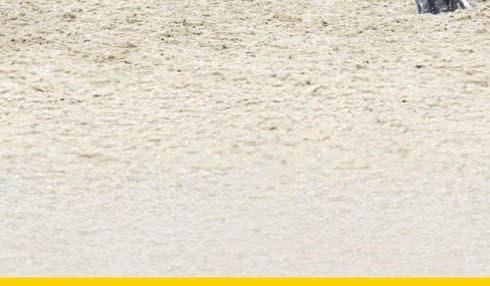

























British Dressage: www.britishdressage.co.uk
e: camille.peters@britishdressage.co.uk
t: 02476 698826
Editor: Jane Carley
e: janecarley5@gmail.com
t: 01926 645981
For the full list of BD O ice sta , visit britishdressage.co.uk
British Dressage, Meriden Business Park, Copse Drive, Meriden, West Midlands CV5 9RG
Main switchboard: 024 7669 8830
Executive: 024 7669 8844
Training & Education: 024 7669 8833
BD Youth/u21 International: 024 7708 7801/024 7669 8834
Membership, Horse Registrations & Results: 024 7669 8832/836
Quest: 024 7669 8908
Sport Operations: 024 7669 8827
Judges: 024 7669 8831
Senior International: 024 7669 8835
Para & International: 024 7708 7803
Fixtures: 024 7708 7804
Championships: 024 7669 8846
BD Shop: 024 7669 8830 – press 1
Finance: 024 7669 8838/841
Marketing: 024 7669 8819
Communications: 024 7669 8842/839
Sponsorship & web ads: 01608 676180
DESIGNED AND PRODUCED BY
Fellows Media: fellowsmedia.com
e: hello@fellowsmedia.com
t: 01242 259241
Fellows Media, The Gallery, Manor Farm Southam Lane, Cheltenham GL52 3PB
ADVERTISE WITH US
For enquiries, contact Jacob Holmes
e: jacob.holmes@fellowsmedia.com
t: 01242 259249
SUBSCRIBE NOW
If you aren’t a member and would like to receive the magazine contact 01442 820580, bd@webscribe.co.uk or mysubcare.com
The views expressed by individual contributors are not necessarily those of British Dressage. Equally, the inclusion of advertisements in this magazine does not constitute endorsement of the products and services by British Dressage.
Many members will be heading to the NAF Five Star Winter Championships next month.
Spring brings the feeling that we can really start to enjoy our horses again after the long, cold and wet winter, and we can finally start to make plans for the season ahead. Many members will be heading to the NAF Five Star Winter Championships next month, having secured that allimportant qualification, or just for a great day out with like-minded friends. The show is really settling into its new home at Addington and it’s a fantastic venue for both competitors and spectators alike.
We’ve put together a number of features for this issue with the competition season in mind, and although they are on diverse topics, a common theme has emerged.
When researching our luxury horseboxes feature we realised that ‘luxury’ can have a number of meanings, whether that’s a sumptuous living area, a dedicated freezer for ice boots away from the ready meals and ice cream or banks of lockers to keep everything to hand. It’s a very personal choice and, budget allowing, go with what makes you happy!
The horsebox has become more than just a means of transport, it’s ‘home on wheels’ and a place for riders and supporters to gather and celebrate – or commiserate.
Sarah Higgins, who had plenty to celebrate at last year’s LeMieux Nationals, gives us the very apt reminder that horsebox gatherings are even more important when you’ve had a bad day and need to decompress. The support of fellow competitors can give vital perspective.
Davy Harvey – who has much to look forward to at the ‘Winters’ again this year – presents some fantastic tips for last-minute training on P31- 34, advising: “try not to want it too much and create stress”.
Each competition is just one step on the horse’s journey, and what might seem a disappointment at the time, could be an important part of his education for the future.
We’re a competitive bunch – we must be or we wouldn’t put all those hours into training – but we must never forget to enjoy it!
Jane Carley Editor, British Dressage
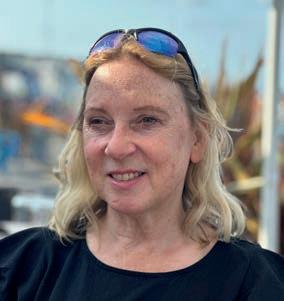























Keep up-to-date with the latest notices, news and views from British Dressage at britishdressage.co.uk

The LeMieux National Dressage Championships returns to Somerford Park, Cheshire from 11- 14 September. This four-day dressage extravaganza is a celebration of all that is great about our sport with championship classes from Preliminary to Grand Prix, culminating in the crowning of our 2025 LeMieux National Champion.
Alongside the competitive action, spectators can enjoy masterclasses and the ever-popular Fan Zone: last year we
got to hear from Becky Moody about her Paris Olympics experience, plus there was a fascinating discussion with Laura Tomlinson and Nicola Baker about juggling motherhood and horses!
It’s a fantastic social event too, with the Shopping Village, extensive catering options and the LeMieux Nationals Pavilion ideal for a catch up with friends.
Early bird ticket deals will be available soon, in the meantime, get the date in your diary !

A Mental Health and Wellbeing course has been added to the BD Learning Hub offering the three-part online learning course that covers all aspects of monitoring our own mental health and personal wellbeing. The aim is to equip members with the knowledge and tools to identify and recognise individual signs when they are ‘not OK’, whilst raising awareness of the importance of our mental health and the impact it can have on those around us. Mental health and equine wellbeing are intrinsically linked, and this module will also provide advice on the impact of our own mental state on our horses, as well as how we handle and care for them.
Following the launch of the three-part course, we will also be making further sub-modules available, offering role-specific education. These will be released throughout the spring and summer months, to include online support for coaches, youth riders and their parents, and competing members of all ages.
The course has been created in collaboration with Riders Minds as an online bespoke resource dedicated to supporting the mental health and wellbeing of all, regardless of age, level or experience. It offers a 24/7 helpline and live chat service, where help and support from trained experts and counsellors is available to all.
Leading sire Negro has passed away as he entered his 30th year.
Owned by Ann And Gertjan Van Olst, in 2024 alone, Negro was the top recorded sire on the British Dressage database, with 48 active, competing progeny earning 1,747 BD test points across the year.
Andrew Gould’s Olympic reserve partner Indigro and 2024 NAF Magic Prix St Georges Winter Champion Ketcher B, piloted by Jezz Palmer, are just two standout examples of his impact in Britain; whilst his influence as a dam-sire can be seen in Nikki Barker’s Dan Icarus (Durable x Negro), Nathalie Wahlund’s Nova Zembla (Secret x Negro) and Chevalier-O (Lord Leatherdale x Negro) ridden by Dan Greenwood, to name just a few.
Negro also played an important role in the outstanding rise in international performance throughout the 2010s, having sired double Olympic Champion, World and European Champion Valegro.























Hello everyone,
I want to start by wishing everyone that is attending the Equissage Para winter championships good luck and congratulations. I will be attending on a couple of the days so hope to catch up with you. As the year seems to be whizzing by already I wanted
to remind you about the Para Home Nations. This is a great opportunity to be in a team with members of your region and also to meet up with the rest of the para community. Make sure you have your scores and training requirements completed in time for the cut off. The selection policy is published on the BD website.
I hope to see you all there!





Tracy Ormrod, Para Director
Date Venue Address Application Deadline
Sunday 11 May 2025Myerscough CollegeSt Michael's Rd, Preston PR3 0RYMonday 31 March 2025
Saturday 12 –Sunday 13 July 2025 Hartpury College, RDA National Championships Hartpury, Gloucester GL19 3BEMonday 2 June 2025
Saturday 18 October 2025 Heel and Toe Children's Charity 40 Front St, Chester-le-Street DH2 1DE
Saturday 8 November 2025 RDA National Training Centre
Lowlands Equestrian Centre, Old Warwick Rd, Shrewley CV35 7AX
Friday 5 September 2025
Monday 26 September 2025
N.B If a hub does not have a sufficient number of appointments to warrant going ahead with it, it will be cancelled.

The first camp weekend of the second British Dressage Para Academy was held at a new venue in October 2024 at Sophie Wells’ (pictured left) establishment, with amazing feedback from all 14 selected combinations on the 24–25 Para Academy. The next camp will take place in April, applications will then re-open in the summer for anyone wishing to apply for the October 2025 – April 2026 Para Academy, which again will be held at Sophie Wells’ establishment.
We are proud to announce that the below coaches have recently qualified as para coaches! A massive congratulations to them all.
• Julie Davies-Bennetts
• Ellen Griffiths
• Victoria Bailey
• Jemma Bentley
• Ellie Maguire
• Jan Hudson
• Tanya Reid
• Jo Swain
• Alice Oppenheimer
• Jan Gay
• Alison Calvert
The 2025 CPEDI and Europeans selection polices are now live on the BD website. Please take the time to familiarise yourselves with them, if you are wanting to compete in CPEDI/s /register your interest for the Europeans this year via the form on the website.











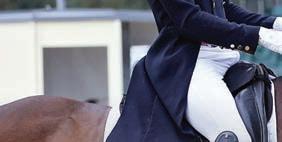
























































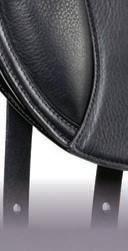






























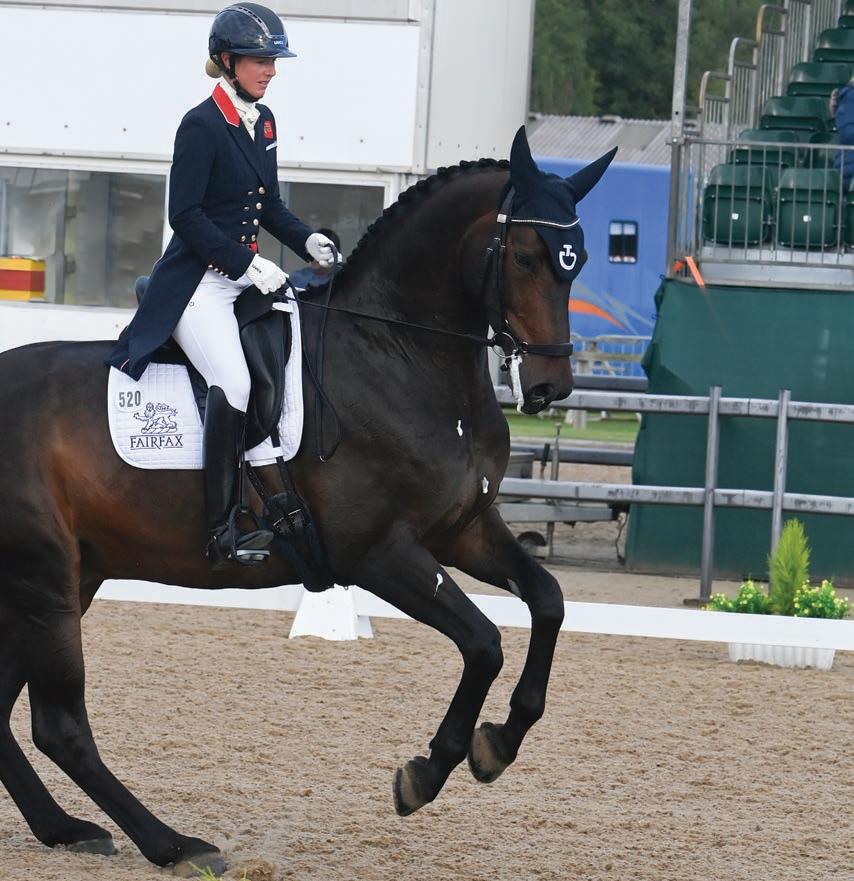


































Happy, healthy horses are at the heart of everything we do at British Dressage. Here we explain more about our Equine Welfare Action Plan
Following the publication of the Charter for the Horse and supporting Equine Welfare policies in December 2023, a great deal of progress has been made in other areas under the direction of the BD Equine Welfare Action Plan.
“We are determined to use events over the last year as a positive catalyst for change,” BD’s Chief Executive Jason Brautigam commented, “We were already committed to this as a core part of our strategy for the next four-year cycle, taking us from Paris through to Los Angeles, and the Equine Welfare Action Plan will reach all aspects of our operations.”
The Action Plan focuses on development in three key areas: governance, training and education, and sport development. “These will all be fundamental to creating an environment where the welfare of the horse is paramount above all considerations”, he added. “Our primary aim is to promote the highest standards of health and well-being for our equine partners, while demonstrating the harmonious partnership that can be achieved between horse and rider through dressage.”
Governance covers the rules, regulations, systems and structure that underpin the sport.
“In this area, it’s vital that we ensure an open and transparent approach, with effective policies and procedures in place to handle any breaches of our equine welfare rules,” Jason explained. “We’ve recently published our Whistleblowing Policy and updated disciplinary processes and would encourage all members to report any concerns they may have so we can investigate matters fully.”
The Whistleblowing Policy is available to view in the BD Members’ Handbook, alongside the disciplinary procedures, which now have a clearly defined framework for the range of sanctions that apply. Cases are handled by the Disciplinary Panel, formally appointed by the Board, to include additional legal, technical and specialist expertise as required.
A designated Welfare and Officials Officer has been appointed, to act as the initial point of contact for escalating any welfare related issues; whilst a new Sport Development Committee has been introduced in BD’s technical committee structure, to bring horse welfare to the top of the agenda and provide direction to the Board on all matters relating to the regulation of the sport itself.

Charlotte Osborne, BD Training & Education Manager, oversees the development of officials and coaches; “This is a central element of the BD Equine Welfare Action Plan,” she explained.
“This year we’re building more equine welfare content into all of our education and development programmes for BD officials and coaches, as well as fully integrating this into our CPD activities.”

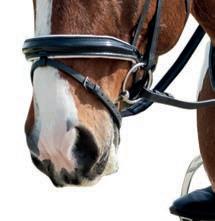

Stewards are an important part of this stakeholder group and will be one of the main areas for expansion in 2025. “We’ll be further investing in our Steward Development Programme, aiming to professionalise and promote this vital role that ensures all rules and regulations are adhered



to at BD events. Alongside improving steward education, longer term we are aiming to establish a new voluntary opportunity to introduce welfare marshals at BD events.”
“Educating members in horse care and well-being is also essential to achieve optimum standards of welfare,” Charlotte added. “We’ve recently launched the BD Learning Hub, where all riders can learn from a variety of online courses.”
“I would encourage all members to attend any in-person or online training events we’re offering, as equine welfare is a
theme that will be embedded in all BD training activity.”
Sport Operations Manager, Lou Jones, is clear that the same principle applies to the sport itself.
“The rules that underpin the sport are vital to progressing the Equine Welfare Action Plan,” she stated.
“We’re planning on undertaking a full review of the rules, which will cover everything from qualification and progression, to assessing the movements required at the higher levels and carefully considering the demands we are placing on the horse.”
It is our collective responsibility to ensure that we maintain the highest standards of equine health, care and well-being.
Looking to the future, the Sport Development Committee will explore opportunities to introduce tests that allow qualification for progression through the levels: “An exciting area of discussion is the potential to add BD rider skills tests,” Lou commented, “These will provide an opportunity to promote the correct use of aids, seat, balance and way of going. Using these across the wider sport could be a positive step in the right direction.”
All work to develop the sport will be done in close conjunction with the FEI and other equestrian governing bodies. “We’ll be looking to create clear guidelines in the area of permitted tack, equipment and aids,” Lou added, “These will help both our officials and members to understand what should be used both at home and in the competition arena.”

YOUR PART TO PLAY
We all have a role to play when it comes to welfare and BD Members are encouraged to be fully familiar with the BD Charter for the Horse and Code of Conduct for Horse Welfare. These are available to view online, in our Equine Welfare booklet and in the BD Members’ Handbook, as well as being available to view in printed format at BD venues across the country.
BD CEO, Jason Brautigam, concluded:
“It is our collective responsibility to ensure that we maintain the highest standards of equine health, care and well-being. To achieve this, we must all consider our own values, attitudes and behaviours, whether that involves looking after horses at home, training them in preparation for competition, or riding in the arena.
“If we all seek to enhance our knowledge and understanding of horses, to improve the level of care that we provide, we can make a tangible difference to their lives, whilst securing long-term public trust in our sport. The BD Equine Welfare Action Plan is just the starting point, and we are fully committed to working with all our members, stakeholders and partners to deliver positive change over the next strategic cycle.”








German-based British rider Susan Pape built a business with husband Ingo producing young horses, but in recent years has enjoyed international success. Jane Carley catches up with her as she reaps rewards from her winter tradition.
When winter bites, many riders would relish the opportunity for some sun, and Susan Pape has been enjoying Florida’s Wellington Festival for some ten years. Aside from the pleasant weather – though Florida had its own brief freeze-up this January – as she explains, one of the benefits is time to spend with her horses.
“I only have three with me this time, Harmony’s Eclectish, the eight-year-old Shiraz and Harmony’s Giulilanta, so it’s very relaxed. The weather is nice and you can ride outside and take your time,
without worrying about the distractions you have at home such as the next horse or doing paperwork!”
She comments that every horse that has travelled to Wellington has become more settled and that the routine allows them to progress.
“We are based at a training barn that’s only about five minutes from the showground, so they get exercised twice a day, hand grazed and walked out. They come home very fit!
“It’s been very good for Giulilanta, for example, who just starting at International Grand Prix, because she can get tight in her body,
Below: Susan Pape enjoying the Florida sun – and a Grand Prix win – with Harmony’s Giulilanta.
Inset: An atmospheric ride at Susan’s base in northern Germany.

mainly because she is busy with her mind. I decided to do a national Grand Prix at the beginning of February just to get her in the ring again and gain confidence and experience. She was marvellous and I was so pleased how she coped with the show situation and how the previous week’s work had paid off. She scored a whopping 76%!”
Susan had laid down her intentions in the first weekend of the eight-week competition extravaganza (Wellington also plays host to international showjumping during this period), winning both the CDI Grand Prix and Grand Prix Special with Harmony’s Eclectish. As the festival continued, she went on to take another CDI 3* FEI Grand Prix, this time with Harmony’s Giulilanta, and followed it up with runner-up slot in the GPS.

It’s the continuation of a career that has seen her nominated for both the Tokyo and Paris Olympics and selected as a reserve for the FEI World Championships in Herning in 2022. She has also been competing at Wellington for 10 years, regularly topping the podium.
If it sounds like the culmination of every pony-mad girl’s dream, that is exactly what it is, but there’s been a lot of hard work along the way.
“I’ve been riding as long as I can remember. I grew up in Amsterdam, where my mother rode for fun, and I always wanted a pony. So when I was five I got Franz, a Shetland, and fell off a lot!”
Harmony’s V-Plus at Aachen, representing Great Britain in the Nations Cup.
Susan recalls that those around her were only interested in dressage, so that was the path she took.
“I always enjoyed it and my mother was friends with Sweden’s 1972 Olmypic Team Bronze Medallist Ninja Swaab, who lived in the Netherlands at the time, so I started helping her. From the ages of 15-16 I groomed for her, including travelling to Goodwood. I was really inspired by that and wanted to make dressage my career.”
At the time, a dressage apprenticeship was not available in the Netherlands, so after visiting the Hanoverian auctions with her mother, Susan applied for training in Germany.
“I got turned down a lot! But I managed to find a placement, took my exams, and got an internship for a couple of weeks with Herbert and Karin Rehbein at Gronwoldhof. I ended up joining their team where I stayed for seven years.”
Duties included grooming for the legendary Donnerhall in the early stages of his career, and Susan was able to train

Good training can develop a horse very well as long as the basics are there.
from third level to Grand Prix.
“It was also there that I met my husband Ingo, and when he eventually returned home to Hemmoor to his family’s business, I joined him.”
While at the Rehbeins, Susan had competed up to PSG, but the business at Hemmoor was initially focused on young horses.
“I did lots of young horse classes – it is how we make our living, by breeding and producing horses.”
“Ingo and I now have a team of very good riders who share our philosophy of training and educating horses. It is based on the German training scale issued decades ago (based on the Army Service regulations of 1912) which describes the goals and principles of dressage with a detailed training plan. Sure, horses have changed a lot since then, however this
path is still quite relevant today.”
The Papes have a dozen mares at their stud in Northern Germany and Susan, Ingo and their team train all of the offspring onwards. Originally they were mainly sold as four or five year olds.
“But now we keep those that show potential for PSG or Grand Prix; the market is very good if they have been trained well.”
Alongside the training barn is their EU breeding facility which houses eight or nine stallions for each season.
“There’s a range of bloodlines; some we have bred, others purchased as foals or are owned by our sponsors, Harmony Sports Horses.”
Susan says that their breeding programme is not necessarily all about bloodlines.
PICTURED
The five- yearold stallion Leclerc (Lord Europe x For Romance).
“It’s important that the stallions have a good, solid background; some have been bred from our mares and we always look at the damline. Producing a good dressage horse is not just about the stallion.”
She adds that all of their broodmares have been ridden.
“So we can see how they are under














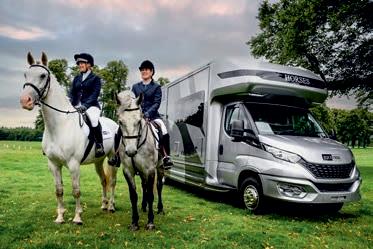



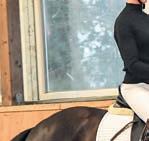
















competition so we can carry on riding them. This way we know the background, their character, their paces and the shape of their body. Of course nature can intervene, but this way we can predict to 80% what the progeny is going to be like.”
When choosing outside stallions, they are not necessarily looking for a flashy type.
“They must have supple and balanced gaits rather than just being big movers. We’re looking for elasticity, a strong back and good hind leg.
“We always look for a good, correct walk. Good training can develop a horse very well as long as the basics are there.”
Stallions available for this year include V-Plus (Vivaldi x Furst Romancier), Susan’s mount at the Aachen Nations Cup in 2024, Despacito (Don Nobless X Sandro Hit), Don Nobless (Dancier x Don Davidoff) and Endorphin (Escolar x Don Nobless).


Youngstock are allowed to mature in their groups before being started as three-year-olds.
“We’ll start them on the lunge and back them and if they need more time then they’ll go back out for the summer,” Susan explains. “Some develop sooner and you can see their paces and rideability and the good ones we can plan to keep. And some that won’t be top class can make really nice amateur horses.”

Once broken, stable riders Greta Heemsoth and Luisa Masur take the youngsters on and develop them through the young horse classes.
“They are really nice riders and can educate the horses well; if you take your time and get a horse to trust you, they can do very nice things for you as a rider. Even if they have not been in a competition, we like to get them
Left: Stable rider Greta Heemsoth with Santos (Secret x Don Schufro), standing at stud at Stall Pape.
Inset: The team at Stall Pape flank Ingo (back row) and Susan (front row).
Bottom: The covered lunging ring at sunset.
out to different venues so that they can experience it, I think it’s important for their development.”
Stall Pape is a prolific producer at the highest level – breeders of Libertat and Sommernacht which took gold medals at the European Young Riders Championships in 2023 and 2024 with Allegra Schmitz Morkramer and Rose Oatley, and at the 2024 Bundeschampionat, Greta rode Felice and the home-bred Endorphin to gold and silver medals.
Susan and Ingo have enjoyed a successful relationship with Harmony Sport Horses since 2012 when Leslie and John Malone purchased Don Nobless, who went onto international success with Susan.
“We’ve known the Malones for more than 20 years and they have given me the opportunities to ride such nice horses. They have invested in horses to keep rather than selling them, so I’ve never been in the position of having a good horse sold and having to start from






scratch again, which might have been the case if we’d owned the horses.”
That said, Susan comments that she still gets a buzz from producing a horse up to international level, which began with Don Nobless.
Other proud moments include those Olympic and Championship nominations, of course, as well as representing Great Britain at Nations Cups.
Very much a believer that you can always learn from others, Susan also works with Gareth Hughes when the pair can fit it into their diaries.
“I really enjoy working with him. Ingo helps me a lot, but Gareth brings new approaches. He is very technical and precise and has some great ideas about riding the movements. Greta has also benefited from his training.”
Susan says that when she returns from Florida in March it is time to plan the season ahead, although the nature of horses means that she takes it month by month.
“There are highlights each year, whether it’s the chance to be considered for a Nations Cup or a Championship. My aim is still to be selected, I always have goals.”
She has plenty to look forward to this year, with V-Plus, on whom she had so much success in 2024, having had a break in her absence, and the exciting prospect Shiraz.
“He was turned away to mature for a couple of years after being gelded, so was only picked up again last year. He’s green but has lots of potential, not a tall horse but has a big canter and is very correct. He’s shown super talent for collected work, too.”
Harmony’s Eclectish, however, will be staying in the USA to continue his career with the Head Rider of Harmony Sport Horses in Kiowa, Colorado, home base of Harmony Sport Horses.
“He’s been a wonderful horse for me, making the Toyko nominated list, and he’s super fit at 16, but now’s the time for another rider to enjoy him and learn from him.”
Susan is also excited about the up-andcoming prospects at home. Although she tends to focus on the older horses, she comments:
“When you get a nice horse it’s exciting to see how they develop, so there’s always one or two of the younger ones that I want to ride.”


PICTURED
Ingo with Greta and Endorphin, after winning at the 4* National Show in Elmohle.
PICTURED
Susan and the 16 year-old Harmony’s Eclectish, nominated for the 2022 FEI World Championships.
Susan is clearly very proud of what stable rider Greta Heemsoth has achieved, taking horses up to Grand Prix for the business.
“She was a finalist in the Louisdor with Anthrazit and is having a lot of success with Boa Vista, on whom she won the German Championship as a five-yearold. She’s a beautiful rider who puts a lot of effort into training and has a love for the horses.”
Susan and Ingo work closely together – he does most of the coaching and develops the breeding plan.
“I either ride or train riders – I can’t do both together!” Susan says. “I feel it’s important to concentrate when you are riding, not be thinking about what your pupil is doing or looking at your phone.”
In common with many riders, Susan feels the pressure of increased scrutiny.
“We need to speak up for our sport and for our training. We don’t have any secrets and anyone would be welcome to come and see how we train and take care of our horses. It’s easy to forget not only that horses give pleasure to a lot of amateur riders, but also that the jobs of grooms and others in the industry depend on them.
“I have recently taken my judges’ test so that I can continue to be involved when I feel it’s time to ride less. I’m still very passionate about dressage and enjoy it very much, and in the meantime I’m looking forward to another good year with my horses.”



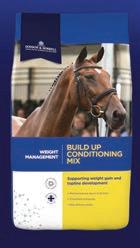






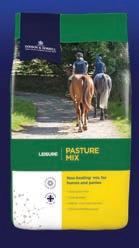






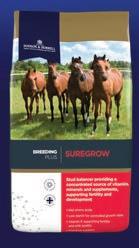



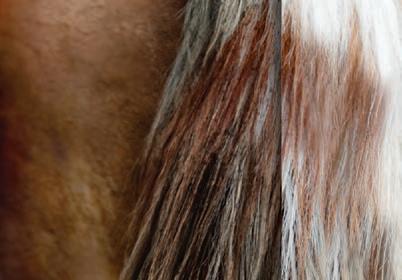


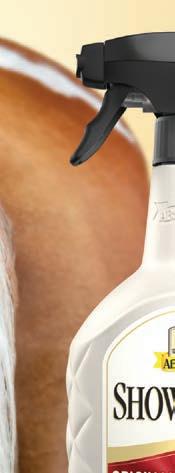












































































Spring can be a challenging time for our horses nutritionally. Stephanie Bateman discovers what to be aware of and how you can support your horse during the spring months.

From increased laminitis risk to weight gain and gastric ulcers, our horses are prone to a number of challenges during spring time.
“Winter is a time when naturally horses lose weight so that coming into spring, they are safely able to gain a few pounds,” says Petplan Equine vet Juliette Edmonds.
“With modern horse management, horses are frequently under-exercised and relatively overfed in winter, with less turnout and exercise to burn calories. Coupled with good forage and copious rugs, winter weight-gain can be an issue meaning an increased laminitis risk when the spring grass appears. Reduced exercise can also mean that Equine Metabolic Syndrome is less well controlled, further increasing the laminitis risk.” Laminitis was one of Petplan Equine’s top 10 most claimed for conditions in 2024.

Some horses are particularly reactive to the change in grass.

As well as weight-gain, we often see more ‘fresh’ horses in spring particularly in those who have been stabled more, exercised less and fed the same energy feed throughout.


“Spring grass is obviously higher in energy levels and some horses are particularly reactive to the change in grass with regards to their behaviour,” explains Juliette. “It is also important to remember that spring grass is quite different in composition from their winter grazing, and to avoid behavioural and colic issues (particularly flatulent colic) changes in the horse’s diet should be made gradually. Limit access to fresh grass flushes and gradually increase grazing time. You could also consider the use of grazing muzzles. Some horses benefit from a probiotic during the transition from winter to spring grass to aid digestion.”
On the flip side, some horses can be dull and lethargic coming out of winter.



“This could be related to weight gain/loss of fitness, or stiffness following longer periods of stabling coupled with reduced muscle tone if exercised and turned out less,” explains Juliette. “Also, prolonged stabling can increase stress levels which increases the risk of gastric ulceration, which can make horses irritable and less happy to go forwards when ridden. Glandular gastric ulceration is more likely as stress reduces the production of the mucus layer which protects this part of the stomach from the acidic gastric fluid.”
If a horse lacks energy, it can be due to certain nutrients missing in their diet.






It’s worth considering that horses fed solely forage over the winter may require a vitamin/ mineral supplement.

PICTURED

Above:
adds Emma. “Fitness levels will also contribute to a horse’s perceived energy levels as will temperament, although this is harder to change.”
It’s worth considering that horses fed solely forage over the winter may require a vitamin/ mineral supplement to ensure they receive the required nutrients without added calories, particularly if the hay fed is cut from the same land they are grazing, as the same deficiencies will be present in both food sources.

“We often find that a lack of energy is a symptom of a shortfall of vitamins and minerals which results from the horse not being fed the manufacturer’s recommended levels of the rider’s chosen mix, cube or balancer,” says Emma Short BSc (Hons), Senior Nutritionist at Baileys Horse Feeds. “Since these nutrients are involved in metabolism and the release of energy from the diet, as well as general well-being, a shortfall can leave the horse feeling lacklustre, lazy and/ or lacking stamina.”
Once the diet is adjusted – either by increasing the amount of mix/cube to recommended levels or by topping up the diet with a low-calorie balancer – the horse feels much better in itself which translates as an ‘increase in energy’.
“For those on a fully balanced diet but still seeming to lack energy, a review of those energy sources and, perhaps, the inclusion or increase of some cereals will provide more quick-release calories which may help,”
“It is better in this situation to use bought-in hay from elsewhere as any deficiencies are less likely to overlap,” adds Juliette.

Equine Gastric Ulcer Syndrome (EGUS) refers to the ulceration of the stomach lining, which can occur due to a number of factors including feeding, exercise and stress. Gastric ulcers were Petplan Equine’s second most claimed for condition in 2024.
Horses stabled for long periods over the winter months with limited access to forage and lack of turnout and exercise can be more prone to ulcers, so what can owners do?
“Feeding management should include the provision of ad lib forage, while concentrate feed should be kept as low in starch as possible, with meals kept small and frequent,” adds Emma. “A small feed containing alfalfa (known to have natural acid-buffering properties) could also be given before exercise.”
A growing variety of supplements are available to help support and aid in the prevention or recurrence of ulcers. Key ingredients may include antacids, soluble fibres and pre- and pro-biotics.
It is a common misunderstanding that winter grass contributes nothing nutritionally, but spring grass offers far more.
“What is true is that spring heralds a new era of significant grass growth,” says Kate Hore. RNutr (Animal). Head Nutritionist at NAF.
“Once the soil temperature reaches 5oC at 10cm depth grass germination gets underway. Spring grass is fast growing with high sugar levels and good protein.”
Pros: As training ramps up for the season ahead, our hardworking dressage horses in full training will appreciate the additional energy and protein of spring grass, as will broodmares and horses and ponies who have dropped weight over the colder months. Cons: Beware the good do-er who hasn’t lost additional weight over winter. Further weight gain now is not only a risk for metabolic disorders, such as laminitis and EMS, but will also negatively impact performance and stamina for training and competition. Monitor weight regularly, and adjust the diet to suit.
A number of nutrients are routinely deficient in our soils, and so deficient in grazing and forage. A lack of biodiversity in modern grassland only exaggerates the issues. Soil deficiencies common in the UK and across Europe include zinc and selenium, both important for muscle health; copper, linked to joint repair and skin condition, and magnesium for muscle and nerve health. Supplementing with a broad spectrum vitamin and trace element supplement to balance the diet is recommended. For hardworking horses in training look for a concentrated balancer to maintain body condition against the rigours of training and travel.
Right inset: Swapping from haylage to hay can be useful for horses suffering from FFWS. Below: Gradually increase grazing time as the spring progresses.


“Research shows that laminitis is a risk all year round, but recent weight gain is recognised as a key trigger, meaning spring, with its rich grazing, is a risk period,” adds Kate. “All owners should be vigilant for not only the classic laminitic stance of individuals rocked back on their heels, but also the subtle signs such as difficulty turning, short, stilted walk, increased hoof temperature and weight shifting between feet. Keep an eye out, and discuss with your vet it you suspect laminitis.”
“FFWS occurs when horses pass normal droppings alongside very watery feces,” explains Kate. “Research is still ongoing, with many factors possibly impacting. However, spring is recognised as a riskier time of year due to the high-water content of spring grass. Supplementing with probiotic complexes, including herbal dietary fibres, is advised to maintain stability in the microbiome. Swapping from haylage to hay can also be useful.”





TOPSPEC ANTILAM FORAGE BALANCER is a palatable, pelleted forage balancer specifically designed to provide five-way nutritional support for those prone to laminitis. It can also be fed to horses and ponies undergoing veterinary care. AntiLam contains a range of highly-effective supplements, pelleted into a cereal-grain-free, low sugar, low starch, high fibre, and very low calorie, ‘non-heating’ balancer base.
RRP: £34.95 for 15kg | topspec.com















MOLLICHAFF ALFALFA OIL is a palatable, high fibre, molasses-free chaff for horses and ponies with higher energy requirements or who struggle to maintain their condition. It’s naturally low in sugar and starch and suitable for horses needing a low sugar diet, with added oil for slow-release energy and to support a healthy coat.

RRP: £14.50 for 15kg | horsehage.co.uk
SARACEN SHAPE-UP

is a low starch, low sugar, low intake muesli balancer. The low feeding rate makes it ideal for good doers in need of weight management, as well as those prone to laminitis. This fully fortified, complete ration contains Acid Buf and a mycotoxin binder to support and maintain a healthy digestive environment. In addition ShapeUp contains a healthy hoof package with a full dose of biotin as well as linseed and Omega-3 fatty acids to support joint health and mobility.
RRP: £24.49 for 20kg | saracenhorsefeeds.com
SPILLERS HAPPY HOOF
MOLASSES


FREE is a low-calorie soft blend of fibres with added vitamins, minerals and biotin. Short, chopped alfalfa and straw help extend chewing time and ultra-low starch and sugar levels make it an ideal fibre for good doers or those prone to laminitis. It’s a versatile feed which can be fed alone, alongside a balancer or compound feed and can be used as a hay replacer. It also includes grass nuts and real garlic for palatability.

RRP: £17.95 for 20kg spillers-feeds.com
FIVE STAR LAMINAZE PELLETS offer five star support for horses and ponies who thrive on minimal feed and can be sensitive to seasonal pasture changes. This advanced formula offers a synergistic blend of key nutrients for a heathy metabolism, hoof support and naturally sourced antioxidants to support the absence of damaging free radical toxins. With added microbiome support and nutrients for overall digestive health, these convenient pellets are easy to feed daily, prior to spring grass growth and all year round for prone individuals.
RRP: £42.99 for 750g and £138.99 for 3kg | nafequine.com


BAILEYS PERFORMANCE BALANCER Requirements for essential nutrients increase with workload, even if a horse maintains condition on forage alone or with little extra hard feed. Performance Balancer supplies these nutrients, without unwanted calories, and can be fed on its own or added to other feeds.
It helps build and maintain muscle and top line, while a full balance of vitamins, minerals and antioxidants support healthy hoof growth, metabolism and recovery.
RRP: around £38 for 20kg | baileyshorsefeeds.co.uk

DENGIE HI-FI MOLASSES FREE is high in fibre but low in calories, sugar and starch making it ideal for those that maintain weight with ease and laminitis-prone equines. A tasty blend of nutritious alfalfa, cereal straw, mint, fenugreek and alfalfa pellets with a light rapeseed oil coating provides slow-release energy and coat shine. It is 100% natural, free from molasses and preservatives.
RRP: £17.65 for 20kg | dengie.com
SELENAVITE E is a comprehensive feed supplement designed to support horse health year-round and supplies 21 micronutrients, including essential trace elements, vitamins and amino acids. It’s especially high in Vitamin E, providing 2,000mg per day, which is vital for maintaining muscle health, immune function and overall performance in horses and ponies. Selenavite E is available in powder or liquid form: choose from a 500g, 1.5kg, 4kg or 10kg tub or a 1 litre or 5 litre container.
RRP: from £12.86 | equineproducts-ukltd.com

LIQUID helps to soothe gastric stress and irritation with natural ingredients. It helps disperse hind gut gas and also forms a protective raft to shield the stomach’s upper area from acid. Suitable for daily or occasional use, it provides fast-acting relief and digestive support.
RRP: £16.50 (500ml), £29 (1 litre), £96 (5 litres) | hbradshaws.co.uk


ELITE SPORT
MUESLI Dodson & Horrell’s Elite Sport Muesli provides performance level nutrition suitable for those with digestive sensitivities. The lower starch and sugar content and high oil formulation provides a steady release of energy for those in moderate to hard work. With essential vitamins and minerals, increased vitamin E and additional digestive and immune support, Elite Sport Muesli showcases Dodson & Horrell’s excellence in nutrition; for healthy, happy horses.


RRP: £21.63 | dodsonandhorrell.com
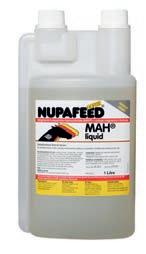
NUPAFEED MAH CALMER Does spring grass send your horse a little over the top? The mineral composition of grazing varies throughout the year and can impact your horse’s behaviour. Notably, grass is lower in magnesium in winter and spring. Magnesium availability is further compromised by the high potassium of new, fast-growing grass.
RRP: from £37.00 for 1L | nupafeed.co.uk
HORSLYX DIGESTION BALANCER Scientifically formulated lick-based nutrition supporting healthy digestion and overall wellbeing. Provides essential vitamins, minerals, and trace elements, offering enrichment. Suitable for laminitis-prone equines when fed correctly.
RRP: £20.55 for 5kg | horslyx.com



CAVALOR ARTI REPAIR supports healthy joints, tendons and ligaments during recovery to fitness. Its vitamins and minerals provide essential components for a flexible musculoskeletal system and joint and tendon health, to support the natural regeneration process of joints and ligaments and bone metabolism.
RRP: £265 for 2kg | zebraproducts.co.uk























Although equine metabolic syndrome or ‘EMS’ is less common in performance horses, they’re not immune to the condition, and this includes those competing at advanced level. We asked SPILLERS Nutritionist, Sarah Nelson, to shed light on what EMS is and provide guidance on how to manage those affected.
EMS is now described as a collection of risk factors for hyperinsulinemia associated laminitis – essentially laminitis associated with a high level/concentration of insulin in the blood. The central component of EMS is insulin dysregulation (ID) which means that to be described as having EMS, horses/ ponies, first must be diagnosed with ID.
Insulin dysregulation is an umbrella term used to describe several abnormalities in insulin metabolism that may result in a high concentration of insulin in the blood (hyperinsulinemia). This includes resting or ‘basal’ hyperinsulinemia, as well as high levels of insulin in response to consuming meals high in starch and/ or sugar.
The combination and severity of other risk factors present varies between individuals but includes:
•Obesity and/ or regional fat pads
•Weight loss resistance
•An imbalance of certain lipids in the blood
•Alterations in certain hormones/ proteins produced by fat cells
The term ‘EMS’ was first coined in the early 2000s and has been the subject of some controversy. The definition has evolved over time, with one of the most important changes being the recent acceptance that not all horses and ponies with EMS are overweight or have regional fat pads – those with ideal or even poor body condition may also be affected.
The oral sugar test (OST) is often used to diagnose ID and involves measuring the concentration of insulin in the horse/ pony’s blood before and after consuming a set amount of sugar syrup given by syringe. Insulin concentrations above a certain level are considered ‘positive’ although the extent of any increase in insulin varies widely between individuals. Insulin dysregulation status also changes and may be influenced by many factors including diet, body condition, age, season and stress, so should ideally be monitored regularly post diagnosis.
insulin dysregulation and in turn, laminitis. In contrast, slimming overweight horses and ponies down to a healthy body condition
Not all horses and ponies with EMS are overweight or have regional fat pads.

can help to improve insulin status. Of course, obesity carries other health and welfare risks including increased joint strain, heat intolerance and reduced fertility (in mares and stallions) to name a few, so the benefits of maintaining a healthy weight extend far beyond the risk of laminitis alone.
Veterinary investigations can be time consuming, expensive and stressful so when a horse needs to go to the vet (as opposed to the vet visiting the yard), ticking multiple things off the list in one visit can make sense. However, when it comes to testing for and monitoring ID, we may need to rethink our strategy as research published in collaboration with SPILLERS*, has shown completing an OST within three hours of travelling could lead to a false diagnosis.
Although lean horses may be affected, there’s no doubt that obesity increases the risk of
Laminitis related to EMS may be triggered by the horse/pony eating enough non-structural carbohydrate (NSC) from feed or forage to cause a high enough peak or persistent increase in the levels of insulin circulating in the blood, although exactly how this causes laminitis is still not clear.
Nutritional management of EMS centres around maintaining a healthy bodyweight and providing a diet low in NSC or ‘starch and sugar’. The different terminology used to describe starch and sugar is a common source of confusion.
Management of horses with EMS includes monitoring body condition score regularly.

•NSC = starch + water soluble carbohydrate (WSC)
•WSC includes simple sugars and fructan, the ‘storage form’ of sugar in the majority of UK grasses
Science continues to show what owners and trainers have known for generations; every horse is individual. This includes how they respond to feeds and forages and as result, how strictly they may need to be managed. If the horse/ pony is severely ID, testing their insulin response to their current or intended feed and/ or forage may helpful.
•Monitor weight and body condition score (BCS) regularly. A BCS of 5 out of 9 is generally considered ideal.
•Exercise can help to improve/maintain insulin sensitivity so continuing with light work rather than giving horses time off may be helpful.
•Restricting access to grazing is likely to be essential and those at very high risk of laminitis may need to need to be removed from grazing completely, especially at certain times of year or during ‘high risk’ periods such as during spring and autumn and on sunny frosty mornings.
•Hay and haylage can be deceptively high in WSC, even if cut from so-called ‘low sugar’ grass species such as timothy.
•Best practice includes having your forage analysed (using the wet chemistry method), choosing a low WSC hay over a low WSC haylage, and feeding soaked hay as a backup or ‘belt and braces’ approach.
•Restricting NSC or ‘starch and sugar’ intake from feed to less than 0.5g per kilogram of bodyweight per meal (less than 250g per meal for a 500kg horse) should be a suitable starting point for most horses that are not severely ID.
•Choose fibre-based feeds that are low in
starch and sugar – whole cereal grains are high in starch.
•Feeds do not necessarily need to be molasses-free to be low in sugar.
•Look for feeds high in oil for those with high energy (calorie) requirements.
•Feeding ‘oil from a bottle’ can be useful for some but it’s important to ensure the overall diet is balanced and provides enough vitamin E. Any oil fed should be fresh and introduced gradually.
•Ensure all feeds (including oil) and supplements are BETA NOPS approved to help mitigate the risk of prohibited substances.
•Contact a nutrition specialist for specific advice, especially for those that are severely ID.
* Jacquay ET, Harris PA, Adams AA. The impact of short-term transportation stress on insulin and oral sugar responses in insulin dysregulated and non-insulin dysregulated horses. Equine Vet J. 2024. https://doi.org/10.1111/evj.14403å



















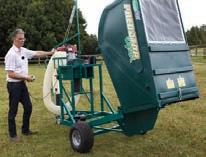









































National title winner Davy Harvey knows a thing or two about preparing horses for championship success. Here, he talks through a typical pre-championship training session and explains how to put the foundations in at home for success on the big day.
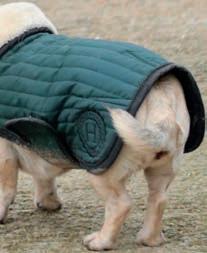
A partnership for four years, the combination has been successful at the
Championships and NAF Five Star Winter Championships.
The best thing you can do before a championship is give a horse con dence.


Right: When I give them a walk break at home, I try to ride the walk more purposefully, as if I am riding the test. It’s easy to let them walk with no focus, on no line. Denzil can easily take over, he then marches too much and I can’t collect, so I try to control the walk and keep him walking confidently but balanced. Riding the test lines is really important for straightness too, this horse also likes to wiggle when on the lines, so I practice these as much as I can in the lead up to a championship.
Right: Riding a small, balanced trot will help focus on your ability to create an organised way of going. I try to focus on practicing transitions within the pace and paying attention to how they come out of the corners. You don’t realise how quickly movements come up as you step up through the levels; when I started riding tests with shoulder in – I wouldn’t get into the movement until three metres after the marker.
If you’re working towards Elementary and above, try riding your shoulder in right out of the corner, it’ll help to practice the feel of how it should be ridden at an event.




Below: By working half halts and corners together, you can better prepare for test movements. I try to think about over-exaggerating the half halt, almost allowing a couple of passage steps before riding into the movement. It sets you up for better test riding and creates a feeling of ‘segmenting’ – trying to get each movement right at a time. I start trying to ride with this mindset three weeks before a show.

Left: I always start and end my sessions by stretching; but with this horse, I then go on to do some half steps before I canter, it really helps him to get his body in the right place before we get cantering. So it’s important to say it’s not always one approach for all.







TO TEST RIDE, OR NOT TO TEST RIDE?










With Denzel, I don’t ride test movements because he’s already predicting what might come next. I do the movements, but I try not to do them on the lines or in test order too much. However, I have a mare who is a little more backward thinking and introverted; I find that with her if she knows what’s coming next and where we’re going, it’s one less thing to think about. I do ride tests with her as I find it gives her more confidence and security. It’s about finding the right solution for the horse. If you’ve got one that’s read the book, do less, if you have one who needs more knowledge and confidence, do more.
This particular horse doesn’t have a ‘natural canter’, so I try hard not to over-criticise this pace in the run up to a competition or championship. Every horse will have a weakest pace, and it’s important not to break down confidence of both the horse and the rider by getting too worked up ahead of a big event. Ultimately, you’re not going to change anything dramatically three weeks before a big occasion.



The important thing is to not try and dramatically change up your routine before an event.

Above: In the canter, make sure you have enough gears to be able to ride a balanced, organised test. Similar to trot, I do an exercise I
where I ride deep into the corner and then ride a half halt over C or A. By doing this, you’re putting the plans in place so that when you’re in the competition arena, your horse is
prepared for you to regroup on the short side, before you start riding the next movement. It’s easy to get stuck on the forehand and then
one problem leads to the next. If the horse is used to the idea of coming back, chilling out and then going again, you can fix any problems that come up on the day. >
It’s imperative that as a rider you know the test inside out so when you’re caught off guard and there’s a mistake, your brain can take over. What I would say to people who suffer from pre-championship nerves is break it down. Don’t get into a mindset where the test starts and you can’t recall what happens until your final halt. Often I tell people I teach to pick a letter or a corner and use it as a check point. When you go past that point, check in with yourself and ask yourself if you’re calm and take a breath. If you get flustered, take those mental check points and breaks.
It’s easy to think more is more. Try not to want it too much and create stress, we’ve all over-cooked it because we want to do well. It’s better to see a rider make a mistake and carry on, than create reactions on the day that aren’t good for the horse.

Above: We’re competing at a level where there are flying changes. So I always ride these down the wall before progressing to the diagonal; I find it’s better to build confidence with the support of the wall, before moving to a line. What I’ve learnt is that the best thing you can do before a championship is give a horse confidence. In the run up, I think about correcting mistakes at home, as if I were correcting them in a competition environment.
I find that when I compete, it shows up the weaknesses in training and they’re not always what you think they are! You also find strengths you didn’t know about too. Competing regularly keeps you out of a rut; when you have to present something to a judge, it sometimes just falls into place. We often go, a few weeks out, to ride the test somewhere else within the boards. I hire Wellington with a full arena. Warm up and do the test –even if it starts to go wrong, keep going! You’ve got to commit to it and see what happens, it’ll give you an honest reflection.
Especially with changes, it’s easy to overcorrect, put in a circle, stop on a line and start again – this is the worst thing you can do; you’re not going to get a second attempt on the day! If you make a counting mistake or there’s miscommunication with your horse, think about fixing it on the go.
If it’s tempi-changes, keep going and stay in the sequence - you can lose more marks by not finishing it and it’s better to practice this in the training arena. Try not to teach bad habits at home, it can create confusion or nervousness, for both rider and horse.
My horses school four times a week, hack twice and have a day off. The important thing is to not try and dramatically change up your routine before an event. Dressage is really training the horse to build enough strength; they’ve got to be strong enough within their bodies to do the movements, so I don’t worry too much about fitness, I find that if the training is right then they’re fit enough. I have one who is a bit curvier, so I try and think about adding a few minutes extra when I’m giving her walk breaks to help her out.
Below: With the younger ones I do a lot of halt training, so it becomes instinctive for them to stand square-ish. To achieve this, I find that if you have them in a good balance, and they’re straight, they’re not normally too bad! The less I’ve stressed about the halt and the more I stress about how I arrive to a halt, the better they are.
If you correct them once or twice, that’s fine, but at a competition you have to run with it. You don’t want the horse to think they’ve done something wrong.














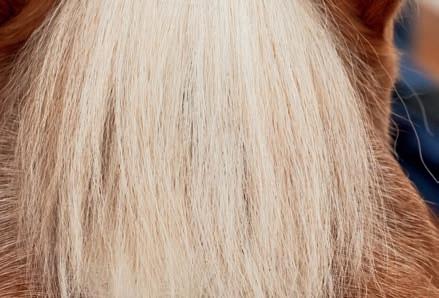












Successful rehabilitation from injury, requires time and dedication and often considerable nancial investment, discovers Helen Triggs.

There is no such thing as a standard recovery. The process will depend on the type of injury, its severity, the length of box rest if required and the facilities available for use, as well as the temperament of the horse. With a cut injury it’s easier to assess healing, whereas a strain or rupture of a tendon or ligament means it can be harder to determine progress.
Owners, particularly those who work full-time away from the stables, can be faced with having to make major changes to their routine to accommodate the rehab programme, having to find extra funds for assistance or even moving the horse to a different yard with the right facilities.
The most important aspect is the partnership with the attending vet and explaining any personal circumstances to them which may affect being able to carry out a rehab regime. Often the vet can suggest adaptations which are possible – it may make the process a bit longer, but can be more easily managed by the owner.
Rehab programmes can be quite complicated and rely on gradual and

incremental changes to the horse’s routine. For example, the regime could be walking for three minutes three times a day for a tendon injury, gradually increasing as time goes on. Sometimes using a walker is allowed –for other conditions the turning circle will not be recommended.
Olwen Lloyd MA VetMB MRCVS has 20 years’ experience in guiding owners through the complexities of rehab.
“Each programme is individual in terms of injury, the particular horse, what the owner is capable of doing and the facilities they have.”
“It’s important to treat the horse both physically and mentally. If you don’t take care of the horse’s mental state when on box rest you could end up with an even bigger problem.
“There are very few injuries where some kind of stable exercise isn’t possible – neck stretches or tummy lifts for example are basic suppling exercises and help the horse when it returns to work.”
Boredom can be a big problem for some horses on box rest, particularly those who are competition fit or used to
Strengthening and postural work can be done even when on box rest.
turnout. If it’s possible for them to walk short distances, then just putting them in a different stable for the day can make a difference. Some horses like to be left alone when they’re injured but others will welcome being groomed, fussed and just having their humans spend time with them, advises Olwen.
So much of rehab is individual to the horse. Some horses don’t do well confined to the stable so it’s a matter of judgment whether and how much turnout would be a better and safer option. “Rehab isn’t always text book,” says Olwen. “If you feel the programme is not working or new symptoms are arising, let your vet know.”


PICTURED
Rehab programmes can be complex and timeconsuming. A rehab specialist such as Zoe Swingler can offer expertise and a consistent programme.
Four years later Sarah did a similar programme with 14-year-old Paris who is still competing at Advanced Medium at the age of 20.
Some owners do not have the time to devote to a detailed programme or the correct facilities at their yard. A rehab specialist can often offer a greater number of modalities and specific facilities such as treadmills, spas etc. Another advantage is the depth of expertise they can offer the owner as they have experienced treating a wide variety of conditions. The owner also has the peace of mind that their horse is safe. They can be there for a few days or weeks.
A rehab specialist can often offer a greater number of modalities and speci c facilities such as treadmills, spas etc.
Some rehab regimes can be taxing for both horse and owner. Dressage coach and rider Sarah Hawkins has been unlucky enough to have to rehab two horses. “Rehab is emotionally draining, mentally challenging and utterly exhausting, particularly if it has to be done in the winter,” she says. “Sometimes we have to give ourselves a break –missing a day won’t necessarily affect the long-term outcome.”
In 2014 Sarah’s horse Roo (Grey’s Rhapsody) was diagnosed with chronic PSD (proximal sensory desmitis). “I think the whole rehab programme was four months and at the end of it she was so fit she could’ve done a 2* event!” recalls Sarah.
“She had shockwave and platelet-rich plasma (PRP) injections, no surgery and an intense six-week walk programme.”
The programme included two weeks hand-walking for half an hour twice a day, then 45 minutes under saddle twice a day for another two weeks and finally 60 minutes twice a day for the final two weeks. For a further six weeks trotting
was introduced very slowly – 60 seconds per day for the first week. Sticking to the regime did the trick and at the end Roo was back to competing at Inter I for a further two years.
Zoe Swingler of NJS Rehabilitation provides specialist rehab support in the North-west and is a qualified equine osteopath. Many of her clients may not have the time or skills to fulfil a complex programme. “Rehab can be very stressful for owners and is very laborious. It’s not necessarily just about the injury – there may be compensating damage as well,” comments Zoe who has private clients and vet referrals. “There is also
PICTURED
Rehab yards can also offer specialist services such as equine hydrotherapy.

a lot of strengthening and postural work that can be done even while on box rest standing still. A lot of muscular development can be achieved just in walk. We can offer treatments such as Indiba, laser and remedial work inhand, including long-reining on our hills and tracks.”
Before committing to sending the horse away, consult your insurance to find out what is covered within your policy. Comprehensive policies may include an allowance for

There are many heart-warming stories of horses who have returned after devastating injuries. Georgia Stokes’ Johnny Cash fractured his tibia and ruptured his patella ligament, came back to competing at medium, then injured his deep digital flexor tendon. He also managed to damage his meniscus in the stable requiring a further session of box rest, then three months


complementary cover and this would normally extend to rehabilitation costs such as livery and therapies.
“It depends on the definitions within the policy; remedial treatment is not
walking under saddle on the roads in straight lines for 10 weeks. He didn’t go back into the arena and canter large for 10 months. “The vet doubted he would come back from his stifle injuries but he’s ready to do his first Prix St Georges and is working some Grand Prix movements,” says Georgia. “He’s my miracle pony!”



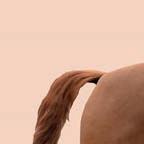

In February 2023, Louise Clark’s horse Dino (DiMaggio’s Hit) rolled under the fence in the field and badly cut his hock. Louise, who works full-time, decided that the best solution was to send him to Langdale Equine, a specialist rehab facility. “If he was at his livery yard on box rest watching his mates turned out he wouldn’t settle and I didn’t want to burden them with the hand walking,” she explains. “At Langdale he could have controlled

necessarily included as standard,” advises Harriet Walker of insurer KBIS. “Any treatment must be recommended by the attending vet and there will be a set limit on how much can be claimed for.”
exercise and I had peace of mind. I wanted to have a water treadmill available for his recuperation. I took him home when he could go in the field. He was back out competing by August.”
So while rehab may seem daunting at the beginning, patience and resilience can lead to a successful outcome.


























EQUISSAGE is designed and produced by UK medical device manufacturer Niagara Health Care. The Equissage handheld unit is the equine equivalent to the version that is used in NHS Spinal injury units, for example, across the country. NHC Cyclo-Therapy can help Increase circulation and improve lymphatic drainage when applied, as well as relaxing muscles and aiding joint mobility. With extensive research on benefits for human rehabilitation, the animal equivalent Equissage is used throughout the veterinary industry on all animals.
RRP: £549 niagaraequissage.com
WATER TREADMILL For use in supporting our horse’s strength, stride and straightness for improved performance, recovery and rehabilitation. With nearly 20 years experience of building treadmills, designing room layouts, installations and thorough training with well respected professionals, we are well equipped to support you whether you’re planning to run commercially or privately. Aqua therapy options are tailored to meet customer requirements, space available and budget.
RRP: £POA | fmbs.co.uk
MUSCLE MAKER is used to aid muscle mass development and is ideal for maintaining peak performance throughout the season and for bringing on slow developers. It contains a natural, high energy body building source and a high concentration of key ingredients including Calcium-Hydroxy-Methyl Butyrate Monohydrate (HMB) and Gamma Oryzanol to aid muscle support and development.
RRP: £59.75 | equineproducts-ukltd.com


COMBI PRO Preparation - Performance - Recovery. These three key elements are what we strive to achieve as horse owners. The Activo-Med Combi Pro rug supports the overall well-being and rehabilitation of our equines. By using specific therapeutic levels of Pulsed Electromagnetic Field therapy (PEMF) and cyclonic massage to aid the body’s natural healing process, the rug can be used alongside daily exercise and for horses with injuries or ailments.
RRP: £POA | fmbs.co.uk
THREE COUNTIES EQUINE HOSPITAL provides a wide range of facilities which allow them to deal with all manner of in-patient and outpatient needs. Facilities include hospitalisation for horses with the capability for full critical care. A fully equipped operating theatre which includes a complete range of AO/ASIF (fracture repair) and arthroscopy equipment. Diagnostic imaging, and a manege to assess ridden and lunged horses.
RRP: £POA | tceh.co.uk


ABSORBINE SILVER HONEY
MINOR WOUND CARE is the first and only combination of natural Manuka honey and MicroSilver BG. Supporting new skin cells by nourishing and conditioning the skin, this barrier ointment/spray soothes and protects whilst helping care for a range of minor wounds. Silver Honey is pH balanced and free of hypochlorous acid.
RRP: spray gel £26.99, ointment £26.99 | absorbine. co.uk


VEREDUS MAGNETIK STABLE BOOT EVO feature 28 magnets distributed in correspondence with the flexor tendons and fetlock joints. Non-invasive and non-doping.Reduces pain and swelling, stimulates blood circulation, accelerates regenerative and processes. Rug, hoof and hock boots and wraps available in black, front or back pair sizes S-L.
RRP: £205 | zebraproducts.co.uk
















ENDURA PRO TREADMILLS have been uniquely designed, tried, and tested for over a decade to ensure very high strength and safety all round. Ideal for rehabilitation work without the danger of daily in-hand exercise and direct equine training. These treadmills provide the most reliable, quiet operation available with highly engineered steel structure, commercial quality gear motor in the low profile drum across 76 micro rollers and advanced control systems.
RRP: £POA Kylixuk.co.uk










































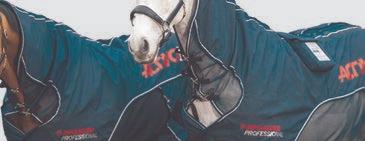


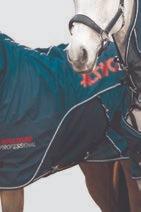
















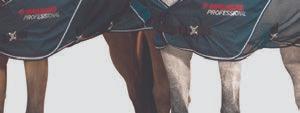






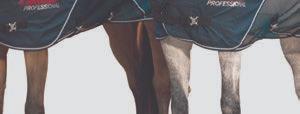









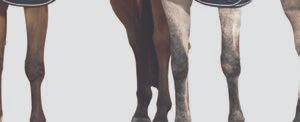



















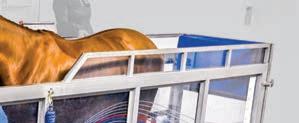


Sustainability is the word on everyone’s lips – but have you considered the impact of your yard on the environment?
Becky Moody shares the steps that she has taken to make horse management ‘greener’ while also saving costs, while ADAS Equine offers some tips on further improvements.



We’re in the process of producing an end of day checklist which includes ensuring lights are turned off; this also offers cost savings. And we’re most of the way through changing our lights to LEDs – it makes a massive difference in terms of the quality of light too – we swapped the ones in our indoor school to LED and they’re so much brighter as well as cheaper to run.
ADAS Equine advice: Other ways to reduce the energy use in lights include fitting motion sensors in low use areas to automatically turn lights on or off, or having lighting divided into sections, so that you can switch on lights in individual boxes or sections of the yard without having to light the whole area.
When designing yard spaces also look to make the best use of natural light via skylights and windows to reduce supplementary lighting requirements.


ADAS will be offering members first class education on how to bring improved sustainability to their stables, along with exclusive offers as part of the BD partnership. Members can expect online webinars, discounted access to an online land and yard management training platform, as well as the opportunity to take up on-site consultancy services.
We have some on straw, mainly wood pellets, a couple on sawdust/shavings and our bedding is delivered in bulk. The wood pellets come from a company that specialises in recycling waste wood, but on the downside, all this type of bedding is packed in plastic.
ADAS Equine advice: Straw is generally a good sustainable bedding source, limited packaging, locally produced and a bi-product of cereal farming. In some locations you may be able to get a straw for muck deal with a local farmer. For other beddings look for locally produced sources, or enquire of your bedding provider what their sustainability credentials are. Look for materials that are bi-products rather than harvested specifically, or look for crops such as hemp and miscanthus that have low input requirements. For large yards buying in bulk loads (rather than bales) can reduce packaging waste, but may have storage challenges.






We put 40 solar panels on the roof of the stable barn which produce 15% of our electricity – we get 7000kwh from the panels and our total consumption is 42,000kwh. In summer a small amount is sold back to the grid.
ADAS Equine advice: Installing renewable energy sources such as solar and wind will help to reduce reliance on fossil fuels or buying electricity from a green energy tariff. Battery storage is also a potential option, to save energy from renewable systems and use it when needed. You can also look to reduce the energy requirements of the yard through actions such as switching devices off when not in use and purchasing energy efficient equipment (e.g. water heaters). For any heated spaces, use thermostats and timers and insulate rooms well, installing self-closing door fittings so doors are kept shut.



Anything that can be repaired to extend its life gets repaired. We donate rugs or anything we are not using anymore to horse charities rather than throw it away.
ADAS Equine advice: When looking at purchasing new equipment think about buying quality that will last, the longer you can use something the more sustainable it is. Look at the materials that are used and try to use ones that are biodegradable or recyclable at the end of their life. Aim to minimise waste going to land fill by looking to rehome, repurpose or recycle before binning it. Buying second-hand is a great way to give equipment a longer life.



We buy our haylage in large bales but the one area where we do struggle is in recycling the plastic wrap.
ADAS Equine advice: Keep hay and forage in a well-ventilated dry barn to maintain quality and minimise waste. When large quantities of hay are purchased get forage analyses done to allow targeting of supplementary feed. Save sweepings from your hay barn to scatter on bare soil in your gateways to reseed. Wrapped hay is a significant source of waste, and there is the ever present baler twine. Keep plastics clean and store inside to facilitate recycling. Ask your supplier if they run a recycling scheme, or work with other yards in the area to collect plastics in bulk and make recycling more cost efficient.
Our muck heap is rotted down and then we spread the most rotted down on land that is going to be rested, and the rest is taken away by a local farmer for spreading.

ADAS Equine advice: Muck is often seen as a problem to dispose of, but when well managed it is a valuable resource on your yard. It is full of fabulous nutrients and organic matter that will help improve the health of your pastures and soils. Keep muck heaps stacked and tidy, ideally turning or putting in aeration pipes to increase the rate of decomposition (and reduce the size of the heap more quickly). Selecting bedding that rapidly decomposes (e.g. chopped straw, hemp, wood pellets) and minimising the amount of dry bedding added will help reduce the size of muck heaps and aid decomposition. Muck should be stored well away from open water (at least 10m) and none of the liquid coming out of the base should be allowed to enter any water courses, ponds or drains.
We have a small rainwater collection system that we use for hay soaking, which I think is a worthwhile thing to do in the UK where we have quite a lot of rain!
ADAS Equine advice: Water usage on a yard can be significant, for drinking, hay soaking and washing. Rain water collection systems are suitable for all those needs if correctly installed and maintained –and they don’t have to be expensive. A clean roof, some guttering and a large tank (preferably dark coloured) with a tap are a basic starting point. Adding a filter (piece of old fly rug can work well) will reduce sediment. To minimise waste water, avoid leaving taps running unattended, repair leaks in hoses and dripping taps. Ask yourself how often do you need to change stable waters? Can you minimise wastage through changing bucket size or location? Utilise waste water from hay soaking and water buckets to irrigate pastures in summer. Do not allow hay soaking water to enter ditches or drains as the nutrients will kill aquatic life.

We do quite a lot of recycling – the girls have recycling bins in their cabin. Hard plastic goes to a local recycling site along with shavings bags and feed bags. We buy anything that we can in bulk, even down to toilet roll and handwash. ADAS Equine advice: Packaging is a real challenge. First look to minimise the amount of packaging that is used by bulk buying. When considering selection of products look at the types of packaging that they come in. For example, paper feed bags are easier to recycle than plastic (some can even be composted on your muck heap!). When buying supplements, can you buy refills rather than getting new plastic pots each time or find new uses for those plastic pots that you do get. Where you do have unavoidable waste look to keep plastics clean (e.g. bale wraps, chaff bags) to enable them to be recycled at a licenced facility. It is also worth asking your suppliers if they have a recycling scheme.


We’ve also got a solar panel on our big horsebox, so we don’t need hook up as much. We try to use our smaller lorry as much as possible, and for stay-away shows, my sister tows a caravan behind it, which also has a solar panel so it doesn’t need hook up or a generator.
ADAS Equine advice: Make sure that your vehicle is well maintained, with correct tyre pressures to improve fuel efficiency. Plan your routes to optimise fuel efficiency (Google maps will help you with this). Also make sure that you turn the engine off when stationary, so it is not sat idling whilst you wait for someone… When buying a new vehicle think about fuel efficiency and what size of vehicle you actually need.




















Long gone are the days of deploying an old school blouse or sweating in a wool hunt shirt in the arena. There’s a wide range of shirt options, with creative use of fabrics to keep you cool and add a touch of elegance. Jane Carley reports.


First things first: what are BD’s rules on shirts?
“A suitable long or short sleeved shirt of a solid colour is to be worn. It should be fastened at the neck with a tie, a round collar or a fastened stock.”
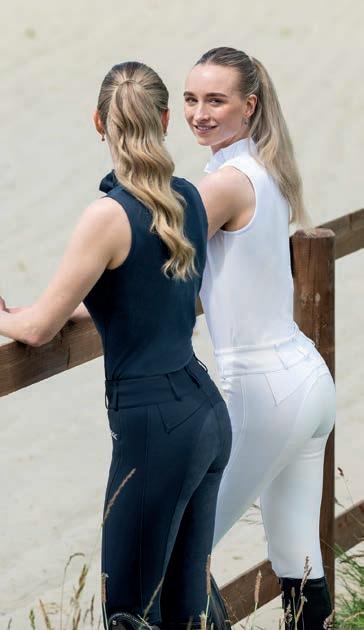



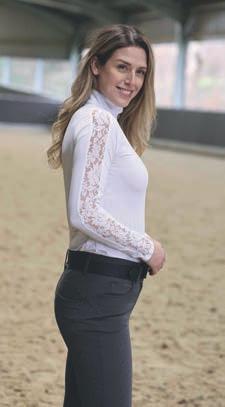
Short sleeved and sleeveless shirts are a brilliant option when temperatures rise (but note sleeveless styles can’t be worn without a jacket).
Or take a look at the Camille long sleeve shirt from Le Mieux if you prefer a bit of arm coverage but still want to beat the heat.
The lightweight breathable crepe fabric delivers performance and comfort and the breathable laced mesh cutouts lend style to practicality whilst keeping you cool in the ring. The flattering sleeves are cut with mesh under the arms and sleeves for maximum ventilation and ease of movement. 1
Mesh makes a real statement in black on Pikeur’s new competition blouse from its Spring Selection Range which utilises long gauze sleeves but still has the traditional white bib front and cuffs to look a little more conventional with a jacket over it. 2
If you are wearing your jacket on hottest of days, Pikeur’s new sleeveless competition shirt is made from 95% Cotton, 5% Elastane, and has a box pleat collar, tapering in the front section. 3




As long as the shirt is a solid colour, you can experiment with embellishment. This can take the form of unusual fabrics, the ever-popular diamanté, or even textures.
The Emily show shirt from LeMieux has a
Mens’ designs tend toward the more practical, but there’s nothing smarter and more comfortable than a purpose-designed riding shirt in a technical fabric.
Le Mieux’s men’s shirt uses a technical base material that effectively regulates heat and moisture through the strategically placed vents under the arm and around the collar. Bonded seams reduce friction against the skin and give a stylish streamlined look There’s also classic detailing such as the concealed button and removable tie loop. 10


feminine LeMieux-pattern flocked mesh on the chest and back panel which is both stylish and provides ventilation for when the heat is on. 4
If you love lace, the Equetech Natalia long sleeve competition shirt features pretty lace panelling down each arm, stock collar and
three-quarter zip for easy dressing. 5
The Ledmore diamanté show shirt from Coldstream is made from recycled materials, offering 50+ UV protection for peace of mind during long days outdoors. Silver diamantés are delicately arranged in a hexagonal pattern below the collar, and there is a concealed zip with a hexagon puller. It’s available in classic white and navy to suit every competition outfit and in ladies and young rider sizes. 6
A huge success in all types of sportswear, technical fabrics give a sporty look and ease of movement while offering breathability and wicking moisture away.
Cavaleros competition shirts from The Centre Line feature breathable, moisturewicking fabrics that keep you cool and comfortable in the arena. Designed for a flattering, athletic fit, these shirts offer stretch and freedom of movement. With an attractive zip fastening and the practical black lower section this one could be a great option for looking smart at clinics, too. 7
If you are all about sleek lines but can’t resist a bit of diamanté, the Maria Diamante Show Shirt from Premier Equine is worth a look. Made from breathable, moisture-wicking materials, its four-way stretch provides a flexible, comfortable fit. A subtle stand collar with diamanté detailing adds a hint of sparkle and luxury. This is available in young rider sizes too, so should be a hit with the teens. 8
For a sporty take on this, the Equetech Mens Elite cool competition shirt – available in XXS, so suitable for boys too - combines a press button-down collar, removable rubber tie stay with an easy-wear zip at the neck. 11 11











Juniors just love bling, so why not indulge them with some shirts offering extra details. Wrestling them into their show gear at the last minute could become a thing of the past!
A couple of options from Le Mieux: The Belle shirt has floral, laser cut panels allowing for ventilation to help keep young riders cool, while glitter piping around the collar and sleeves adds a subtle touch of sparkle and fun. And for those first competitions, the Mini Bella has an allover silver pony print and a hint of sparkle on the manes and tails, making this shirt look extra special. It’s finished with a crystal popper at the collar for a comfortable fit and easy buttoning, and a glitter trim at the collar and cuffs for an extra special sparkly look. 12 & 13
Both practical and smart in navy, the Mini Giulio boy’s long sleeve show shirt from Premier Equine is made from technical four-way stretch pique jersey. The classic cotton poplin button-down collar and button-up sleeve cuffs add a timeless, polished touch. 14
A quality belt will help to keep shirts tucked in and


adds a touch of individuality.
Peachy Belts has a wide range, but this navy ostrich-look design with a white oval diamante buckle is a popular choice. A belt also makes a great gift from non-horsey loved ones, so start dropping hints in time for birthdays, anniversaries or even next Christmas! 15
Stand up collars on shirts come in lots of different designs and mean that it’s not essential to wear a stock or tie.
The stock – which has its origins in providing neck support for riders out hunting – is however, a great addition for a special championship or just for that extra glamorous finish.
Pikeur’s Plastron takes the hard work out of stock-tying and comes with three interchangeable silver brooches. 16
Pikeur has also modernised that most traditional of accessories, the tie, putting it on an elasticated band to go under a button-down collar for easy last minute preparations. 17
Did you know that fitted waistcoats are now permitted at Championships as well as other affiliated shows? A great option when the temperature goes up but you still wish to look elegant and put-together.
The rule goes: Any single colour tailcoat or jacket or fitted waistcoat will be allowed. Tweed jackets and waistcoats are permitted but should not have bold patterns.
Accents, such as collars, cuffs or points of a different hue, modest patterns (including pinstripes) or crystal decorations are permitted. Gilets are not permitted.
Lotus Romeo waistcoats from The Centre Line are designed with a tailored fit and made from premium materials. They offer a sophisticated silhouette while ensuring comfort and freedom of movement; lightweight and breathable, these waistcoats provide a polished look without restricting performance. Available in a variety of styles and colours, they allow riders to express their individuality while maintaining classic equestrian elegance.
































LOTUS ROMEO’S mesh jackets and tailcoats redefine equestrian elegance with cutting-edge performance. Designed for style-conscious riders, these pieces offer exceptional breathability, stretch, and a flattering fit. The lightweight mesh fabric keeps you cool under pressure, while impeccable tailoring ensures a polished competition look. Lotus Romeo blends tradition with innovation, providing comfort and sophistication in every ride.
RRP: from £525 | lotusromeo.co.uk / thecentreline.co.uk
CAVALLERIA TOSCANA MEN’S TECHNICAL KNIT COMPETITION
TAILCOAT has breathable and water repellent four-way stretch fabric allowing unrestricted movement, antibacterial properties and UV protection. Bottom tails include removable weights for stability. Machine washable 75% Polyamide, 25% Elastane. Available in black or navy, European sizes 44–52.
RRP: £1,050 zebraproducts.co.uk



LEVADE LADIES LEATHER
EQUILINE COMPETITION SHIRT LILY
Experience a blend of elegance and performance with the Equiline Lily women’s competition polo. Crafted from technical piqué, this polo offers a sophisticated touch to your equestrian ensemble. The poplin collar with hidden buttons exudes classic charm, while the closure with buttonhole buttons adds a polished finish. Adorned with a black logo embroidered on the chest, this short-sleeved polo is a symbol of style.
RRP: £120 | royalequestrian. co.uk

DRESSAGE RIDING BOOTS These exceptional long leather horse riding boots are crafted specifically for dressage from high-quality European and patent leather. The traditional knee-high length is embellished with patent leather around the outer calf and a metallic detailing at the knee. Available in both grey and black.
RRP: £240 | premierequine.co.uk




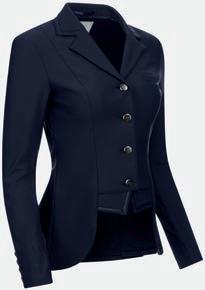
JACKET Ideal for dressage competition wear, the sleek and sophisticated silhouette of this jacket combined with the subtle LeMieux branding helps you look and feel your best at shows and events. Tailored sleeves with mesh underarms deliver clean lines and optimum breathability, meaning you’ll stay cool when the pressure is on. The sparkle silicone detailing on the collar and belt gives a subtle dazzling finish, with a split vent back feature for an elegant silhouette. A simple stud button front fastening makes for easy, fuss-free changes. Available in navy and black, in sizes 6–18.
RRP: £199.95 | lemieux.com
GATCOMBE LONG SLEEVE SHOW SHIRT is designed to maintain style even in colder months.








EQUETECH PREMIERE CRYSTAL TAILCOAT is styled in a high-quality, fourway stretch fabric featuring exquisite embellishments, including a crystal-encrusted collar and faux waistcoat points. The tailcoat is cut from a high-quality, four-way stretch fabric with a showerproof coating offering protection against the elements. Finished with a mesh lining to boost breathability and ensure riders stay cool in the saddle. Machine washable with an innovative wipe-clean tail lining. A stunning tailcoat at an affordable price. Sizes: 32”–44” in Navy.
RRP: £269.95 | equetech.com









Crafted from smooth, soft-touch fabric, the main body is complemented by a contrast woven bib, collar, and cuffs for a sophisticated touch. The shirt features a high build embroidery pattern on the placket and cuffs, with concealed snaps for a sleek finish.
Finished with a mesh lining to boost breathability and ensure riders stay cool in embroidery pattern on the placket





RRP: £79 | hollandcooper.com





CAVALLERIA TOSCANA
WOMEN’S TECHNICAL KNIT
TAILCOAT has breathable and water repellent four-waystretch fabric, allowing unrestricted movement, antibacterial properties and UV protection. Bottom tails include removable weights for stability. Machine washable. 75% Polyamide, 25% Elastane. Available in black or navy, European sizes 36–45.

RRP: £1,050 zebra products.co.uk


ARIAT introduces the refreshed Palisade Boot Collection, featuring three refined styles: Palisade Field, Palisade Dress, and the all-new Palisade Lace. Designed for riders of all levels, these boots combine premium full-grain leather, a contoured fit, and a sleek European-inspired silhouette. Enhanced durability, a modernized topline, and advanced comfort features ensure exceptional performance in and out of the saddle. Perfect for training, competition, and everyday riding, the collection redefines equestrian footwear.
RRP: from £300 | ariat.com
FRAC PREMIUM COMPETITION JACKET features breathable, stretch fabric for optimum freedom of movement and comfort. Elegant cut with ultra-fine Swarovski crystal decoration. UPF 50+ for UV protection. Durable construction with wrinkle-resistant finish. Machine washable.
RRP: from £544 | samshield.com/en


















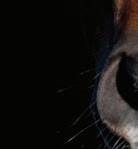



































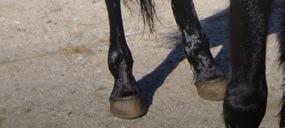

























Luxury in a horsebox can mean anything from a brand-new top-of-the-range lorry, to taking your best glasses, crockery and cutlery with you – and the best parties, as Emma Penny discovers.
Fifty years ago, luxury was towing a caravan behind your converted cattle wagon, but it has evolved into the high-spec vehicles being produced today, bespoke builds, optional extras –and taking home comforts as well as horses on your travels.
With the lorries themselves, Equi-Trek CEO Tom Janion says: “Many of the luxury extras were not even available 50 years ago, and horse owners have become much more affluent and able to afford luxury horseboxes that incorporate everything that modern technology has to offer.”
Equi-Trek’s current top-of-therange box is the Evolution, built on a new 7.2t Iveco chassis with a payload of up to 2.5t, though the firm is currently designing a new range of boxes up to 26t. And while the Evolution is top-spec, upgrades include slide outs, touch screen control of lighting and heating, and air conditioning for horses and humans. Its classic

models can be upgraded with various options, and it also builds bespoke boxes, says Tom. “Alterations to the size of the horse and living areas are the most common, including separate bedroom, disabled facilities, full size washing machines and dishwasher.”
However, additional items will affect the vehicle’s payload, he adds. “All our horseboxes have an approximate payload as a parameter for customers to follow when considering all their
optional extras and the weight of their tack, horses, passengers and fuel. Our extras are listed with the additional weight, so we can easily calculate the payload alteration, and customers can make informed choices before they commit.”
While many today will opt for a lorry built on one of the lighter van-type chassis, such as the Iveco used by Equi-Trek, it’s traditionally been the case that anyone looking for ‘luxury’ and carrying a couple of horses would

buy a 7.5t horsebox. However, payload is often an issue, says Wayne Robbins, MD of STX-UK.
“Most ‘luxury’ 7.5t trucks have less than 1.5t as a payload, and by the time you’ve added tack, fuel, water, and a couple of people, you are then below a tonne. Two decent 16.2’s will mean you are then over-weight.
“We also have the issue of younger riders not being able to drive a 7.5t truck without taking extra tests. So, the move to either downsize to a 3.5t, or move up to a 10t+ truck has been the norm of late – a normal, well built, 3.5t can have almost as much payload as a traditional 7.5t truck these days.”
He says the term ‘luxury box’ means different things to different
Above: Equi-Trek’s Evolution horsebox incorporates luxurious living as standard, but can be upgraded to the customer’s requirements.
Left : Slide outs in the living of the EquiTrek Evolution can offer even more space.

people. “From our point of view, luxury starts in the horse area. While it is nice to have a wine cooler, a safe and spacious horse area is a priority.”
For STX, a key point of difference is offering the tallest internal height of any big truck, helping to maintain good air
As well as providing the best ‘luxury’ travelling conditions for horses, there are any number of optional extras available for the horse area.
Lancashire-based JM Horseboxes offers a number of high-end ‘wish-list’ options, including a Drimee solarium
While it is nice to have a wine cooler, a safe and spacious horse area is a priority.
quality for equine passengers. Its horse areas also have cushioned rubber flooring, full-length padded partitions with large folding headboards, an extractor fan for every stall, and roof window vents.

THE ESSENTIAL LUXURIES... Luxury doesn’t just mean buying a fully-loaded lorry, according to competitors that we polled. So, what were the popular (and sometimes surprising!) luxuries?
• Fresh flowers in a vase
• Optics, a fully stocked bar and snack cupboard
• Proper plates, glasses and cutlery
• Board games, especially Uno and Rummikub
• Coffee machine and toaster
• Fairy lights, cushions, electric heated throws
• Matching luxury bedding and soft furnishings
• Fluffy blankets and fluffy slippers
• Ice-making machine (for refreshment purposes!)
• Radiator in the bathroom for hot towels
• Air fryer and dishwasher
• Lots of heating
• Books and DVDs
• For trailers/camping in the horse area, an insulated tent
• Mattress topper and hot water bottles
• Comfy folding chairs and table for outside
• A chef – and endless champagne!



mounted in the roof, waterproof electric sockets, a waterproof speaker system and a low wattage bar heater, ideal for drying jackets and so on, says the firm’s Martin Taylor.
It recently built a box for Whitehill Stud, and rider Jess Dunn says one of its luxuries is a freezer
built into one of the external lockers to store the horses’ cold boots. “It’s much bigger than the one in the living and stays cold all day. We also have a larger bathroom pop-out and have wifi which is brilliant when there’s no phone reception and for watching Netflix when we are abroad.”
For Cheshirebased Sarah Higgins, a lorry TV and Sky subscription is a highlight so she can ‘keep up to date with Love Island!’. However, she adds that one of the greatest luxuries is a warm and comfortable bed. “A good memory foam mattress is brilliant; when you’ve been riding all day you need that.”
Becky Moody loves the underfloor heating in one of her owner’s boxes. “It can be left on
There’s one ingredient that’s essential for the best lorry party; the people!
While Sarah Oppenheimer’s ingredients for a good lorry party are lasagne, all types of bubbles and paper towels, she adds ‘make sure you have a great fun group of people around you!’
That point is echoed by Sarah Higgins, who says lorry parties are crucial when it’s been a ‘rubbish’ day. “When you’ve had a bad day, it’s important to spend time with friends and not to get too wound up about it – but it’s great to celebrate when you do well.
when you are at a show so it’s always nice and warm.”
Underfloor heating is one of the long list of possibilities, with multiple pop-outs, mood lighting, all kitchen mod-cons and a bathroom which includes a proper shower and heated towel rail just the start.
Quartz worktops, a Belfast sink, coffee machine, Playstation, dishwasher, air-con, wine cooler and so on all add to the luxuries inside, with outdoor options including a washing machine and drier, heated underfloor storage, heated rug racks, hot and cold horse wash, bar and BBQ and outdoor tv and sound system. It’s possible to go even more high end; Martin says one of his customers recently sent precise measurements for fitting out a drawer for champagne flutes.
Luxury can also mean being able to run everything on your lorry without worrying about running out of power; Becky says

“If you don’t make the effort to socialise and spend time with people, it can be a very lonely sport. I have some amazing friends who are always good to celebrate or commiserate with, and it also makes owners feel part of a bigger thing.”
Plenty of wine and gin are on Sarah’s list, and ‘being warm is an absolute priority!’. When it comes to food, she says Sarah Rao is often
solar panels have been a great option and means she doesn’t need hookup.
While manufacturers can add pretty much anything you want – with payload limits considered – it doesn’t mean you should, says Wayne, sounding a note of caution. “Building a 26t truck with just two stalls and massive living might work for you, but will not work for everyone else and can be nightmare to sell on. It’s important to get the balance between ‘bespoke’ and ‘residual value safe’.”
With such a huge variety of options available, manufacturers can offer almost anything. But even with a Euromillions winner’s budget and a temptation to go overboard, it’s perhaps best to keep Tom Janion’s advice in mind. “A well-designed, aesthetically pleasing look and feel, teamed with ease of use, practicality and comfort are the essential ingredients of a luxury horsebox.”
in charge of catering. “It’s often a bit like a hotel buffet – we’ve had pizza, rice and ice cream all at the same time. It’s unusual catering, but it works!”
Becky Moody says her mum and Jo, one of her owners, are excellent cooks, with good people and good food making for an excellent evening. “Jo does a lovely savoury aubergine cake and makes an amazing but much less nutritious Nutella cheesecake!”




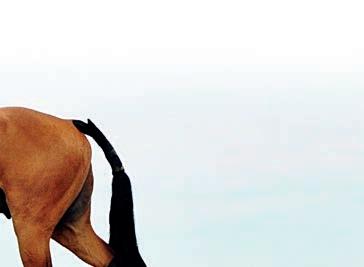

Why risk breaking down in your horsebox or towing your trailer without the best breakdown cover that’s available.
If you’ve ever had to pull up and switch on the hazard warning lights, your immediate thought was probably for the safety of your horse or horses on board and hoping this is not going to be a huge problem so you can get going again as quickly as possible, especially if you are on a busy main road or motorway. If you are fortunate enough to be an existing member of Equine Rescue Services – The UK’s leading provider of horsebox and trailer breakdown cover, you will be able to reach for your phone and dial their number.
As soon as the call is answered, our members can rest assured that help will soon be on the way. Our Specialist Equine Incident Management Team is on hand from the start when horses are on board, to co-ordinate, advise and ensure the welfare and safety of our members and their horses are given the
priority and care needed, working alongside our mechanical breakdown service.
Membership packages start with Trailer Assist which costs £58 per year. It is a small price to pay to be able to travel with peace of mind, safe in the knowledge that if the worst should happen you won’t be stranded for long.

“This is the second time I have had to use your services, and I cannot recommend you highly enough. Everyone was very friendly and extremely helpful, keeping me informed and calm enough to drive home.” Victoria 12 February 2025.
“Brilliant service, people answering the call are lovely and provided prompt action and great communication throughout the breakdown to keep me posted on what’s happening. Also like to say the recovery teams have also been very friendly and efficient. I will add I rarely give such good feedback, very impressed with the service.” Gemma 25 February 2025.

You can save 15% on any new membership package, by using the promotional code: BD15. Simply call the team or visit the website to redeem this offer. The amount that you will save on each membership is shown below:
“Delighted with every aspect a massive thank you!” Jan 3 March 2025.
Equine Rescue Services has some highprofile admirers, as many professional riders need to transport their horses to and from competitions with the confidence that if their vehicle does breakdown they will still get to the destination in time.
“Equine Rescue Services cover all three of my lorries and the breakdown cover that they provide is really important to me when travelling with my horses.”



Nat Campbell, Andrew Gould’s travelling head groom, has some great tips for getting organised to go away for a stay-away show and shares her experiences.
I start preparing a week before we go. I always make a list of what we need to take – either in a notebook or on my phone, but I find it helps to write it down.
Once the season starts, some items stay on the lorry so I don’t have to worry about packing them. This includes show rugs and clean feed and water buckets – ‘show buckets’ are red, so they don’t get mixed up with the others.
I always keep a supply of clean numnahs, boots and bandages in the tack locker too.
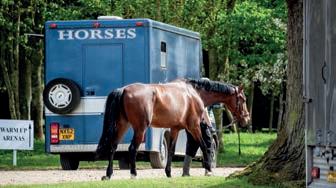
We use big bale hay so I load up builders’ sacks with a couple of sections of hay per day, per horse. I always take more than we need, but I don’t want to run out and then change their hay at a show.
I tend to take a full feed bag of the horse’s rations; I’ll also record the batch numbers when we are at an international show for Clean Sport traceability.
We don’t use a lot of supplements, but I do find the empty tubs handy to soak a small amount of sugar beet or make up a mash when away from home.
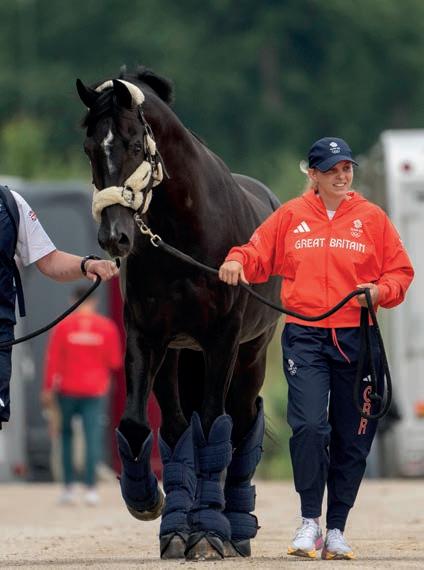
I ensure that the Activio med rug is in the lorry, plus the ice boots which have their own little freezer so they are ready to use.
Another must is recovery mash; it keeps horses hydrated and you can always tempt a horse that doesn’t want to eat or drink.
At international shows we are required to check the horse’s temperature twice a day and record it on the FEI app, so I’ve got a thermometer in the lorry as well as my grooming box.
We have a first aid kit with all the essentials: Animalintex, Vaseline, wound cream etc plus a clean tail bandage, which stays on the lorry.
A few days before I’ll check my list for what I need for each horse that is going to the show.
I don’t take much bedding due to space, but may take an extra bale of shavings.

It’s always the last thing to pack as Andrew likes to ride the horses that he’s taking in the morning before we leave. So he rides, I clean the tack and it gets packed.
The fork and broom plus a skip bucket live on the lorry, but I have to remember to pack the wheelbarrow!
The passports are one of the last items to pack – I put them on the cab seat; if they are not there, I know we haven’t got them! My own stuff goes on first, not at the end, otherwise it gets forgotten!
My phone! It helps me to find Andrew, tells the time, and it’s where I find all the details of test times, prize givings, results etc. Not only do I rely on it but Andrew does too!
I try to clip the week before a show so that their coat has time to settle down – it looks much better.
Any trimming or tidying is done and I make sure the mane is ready to plait. They all get a bath the day before we travel and I put baby powder on white socks and plait tails up.


All horseboxes and trailers must be correctly maintained and serviced in line with the manufacturer’s warranty. At Equi-Trek we would always recommend that horse trailers have a yearly service to ensure they are road worthy and safe. A horsebox will also require an annual MOT test.
Lubricating any moving parts on a regular basis will help reduce wear and tear from a maintenance perspective.

Tom Janion, CEO of Equi-Trek, offers some pointers for stress-free travel.
Thoroughly checking your horsebox or horse trailer before every trip is your responsibility to ensure you are travelling safely on the road.
• Ensure the tread on the tyres meets the minimum legal requirement and check the tyre pressure. Correct tyre pressure for each individual horsebox or trailer can be found in the manufacturer’s handbook.
• Check brakes are working correctly and not stuck on, plus brake lights if you are towing.
• Check all lights are working correctly and that wiring is secure.
• Inspect flooring and ramp before loading.
• Check fluid levels – including fuel, oil, Ad-Blue (if applicable) screen wash and anti-freeze.









When it comes to payload, always check that you are within the payload allowed. The only accurate way to check you’re not exceeding the payload is to weigh your kit, your horses, any passengers you will carry and to find out the weight of anything else extra, such as a full tank of fuel.

Make sure items are secure when packing up your horsebox or trailer. As a rule of thumb, heavy items should be packed at ground level and towards the front of the trailer or vehicle. Lighter items, such as rugs and bandages can go up top on any racks.





Adjust the partition for your horse and always ensure there is adequate ventilation for the journey. Check haynets are correctly tied and are high up so the horse can’t become tangled in one.






Another simple task when returning from an outing is cleaning your horsebox or horse trailer. Making sure it is dry and ready for the next trip will also help prevent materials from deteriorating or corroding and improve longevity. It will also be much easier to inspect and spot any potential issues before you are back on the road again. If you use shavings or bedding in the horsebox or trailer, we recommend cleaning this out after every trip.











Above: Amy Woodhead enjoyed a tally of eight titles across both Bishop Burton and Arena UK’s Winter Regional Championships. Emma Blundell’s promising young mare MSJ Vienna (Vitalis x Jazz Rubin) was the top Arena UK scorer notching up 76.467% in the HorseHage Preliminary Gold.

Above: Riding Emma Blundell’s nine-year-old mare Mount St John Diamonds Are Forever, Somerset’s Alex Harrison made it local success at Chard Equestrian, winning both the Magic FEI Prix St Georges Gold and the Superflex FEI Intermediate I Gold classes on 70.39% and 72.84%
Right: 21-year-old Lauren Burrows and Elizabeth Frampton-Hobbs’ Beaux Lyon (Beltano x Herzensdieb) earned two regional titles across the Chard and Wellington fixtures. They collected tickets to the NAF Five Star Winter Championships in the Baileys Novice Freestyle Silver, qualifying on an outstanding score of 77.13%, and the HorseHage Preliminary Silver.

Members have been busy qualifying for NAF Five Star Winter Championships, being held at Addington, Buckinghamshire on 16-20 April, in recent months. Some 1600 centre lines were ridden in 132 classes at eight regional championship xtures to win their place in the spotlight. We highlight a few of the successful partnerships.

Lancashire’s Jessica Dunn was the main event at Myerscough College, securing three wins and top placings with several horses owned by White Hill Stud’s Jennifer Whittaker. Pictured is Lord Lenny, who claimed the Black Country Saddles Advanced Medium and the Nupafeed Advanced Medium Freestyle Gold with scores of 70.65% and 71.99%.






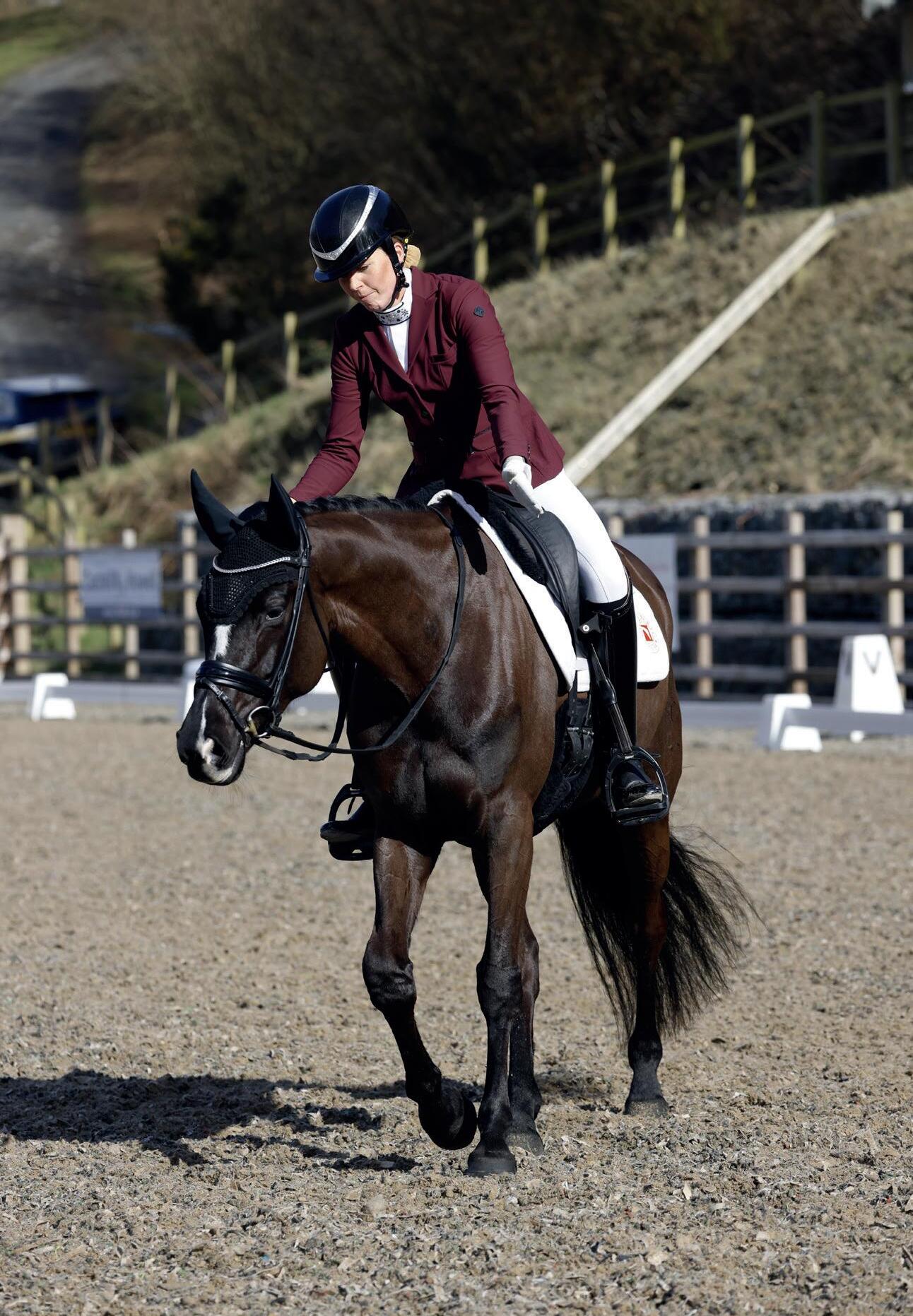
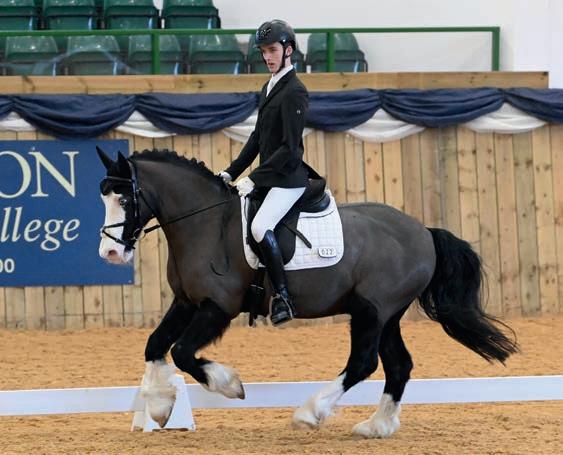



Continuing our series on often-overlooked aspects of dressage performance, Andrea Oakes considers how to help the horse compete without stress or negative tension.
Agiveaway clue told rider and trainer Nikki Barker when her first grand prix mare, Pasoa, was relaxed in her work.
“When she was piaffing well, her ears flopped to the side and up and down,” says Nikki. “That’s a sure sign of relaxation; when you say now trot on the spot, with as much power as you can muster, and the horse appears to understand what you ask and makes it look easy.”
Making things look easy wins the marks, says Nikki, who likens a top dressage horse to a ballerina who can leap or pirouette on one toe with effortless grace and elegance.
Yet this tricky balance of relaxation and physicality is required throughout the levels, whether the horse is performing a
Nikki Barker learned the signs that showed her mare, Pasoa, was relaxed in her work.
20-metre circle or passage.
“For me, a relaxed horse is one who works without stress or negative tension,” says Nikki, who points out that he must first be both physically strong and knowledgeable enough to perform the exercises asked of him. “But we’re not talking about the sitting on the sofa, feet up, watching a movie kind of relaxation. A horse needs an element of positive tension in his muscles to draw himself up, without being stressed by it.
“What we’re aiming for in performance is the positive tension that makes him lift through his tummy and arch his neck when he meets a new neighbour over the field fence,” she adds.
“A relaxed horse is happy, not anxious, and not pushed too far out of his comfort zone.”
Nikki explains that true relaxation is evident from the ‘swing’ in a horse’s movement.
“The power comes from the hind leg and swings through a working back to a steady bit,” she says. “With more swing comes expression. As the horse pushes harder from behind and steps with more force, the energy travels through his body and allows the front legs more time to float in the air.
“To develop this relaxation and swing, you need straightness and suppleness,” she adds. “The horse must be in a good rhythm and balance, so follow the scales of training and use lots of transitions. Even when riding a baby horse, can you look in front and turn him an inch to the outside and then to the inside? And
then move him to each side from the withers? You should be able to control different parts of the horse’s body and completely give and retake the reins, with him remaining in a frame and in proper self-carriage.”
With these correct foundations in place, how can we add the power, or pizazz, while ensuring the horse remains relaxed?
“Balancing keenness and energy can be difficult,” says Nikki, who points out that we are, after all, dealing with a flight animal. “Some horses are more ‘goey’, with a natural tendency to stress. It’s a fine line to push a horse a little out of his comfort zone for more, where new muscles can grow and strength can develop, but not where negative tension surfaces.
“It’s easy to add a bit of power or speed to produce flashy paces, injecting oomph so the horse looks flamboyant,” she explains. “But using this short-cut to power up the horse from behind can mean losing the swing. Expression comes from a swinging back, so the tail is often a giveaway as it’s an extension of the horse’s spine. Does the tail appear ‘dead’, or held like a banner? Or does the dock arch nicely in a semi-circle as the tail flicks and swings?”
If negative tension creeps in, Nikki suggests returning to basic exercises.
“To be relaxed, a horse must be ‘selfgoing’ but willing to wait for you,” she says. “Try trotting half a 20m circle to a halt. Then ask for a turn on the forehand and rein back, before trotting on again. This encourages the horse to be supple each side, through the ribs, and ensures he waits and listens.
“Horses often become more relaxed when you ride the same pattern several times, which is why tests are so tricky and where the degree of difficulty comes in in the freestyle. Giving a horse a predictable pattern will help.”
The ultimate challenge is achieving relaxation at a show, amid the nerves and excitement.
“The aim is to give the horse the best possible chance of succeeding,” says

A set routine was the key for Jane Van Seelen Hansen with the ‘hot’ Missy II.
Nikki. “Try to identify what works, whether that’s stabling him at the venue the night before, hand grazing him or travelling with his friends. What helps that individual feel confident in a new environment?
“If it all goes wrong in the test, the ring is not the place to fix it,” she adds. “But while you might not salvage the score, you can try to give the horse a good experience. If he’s bubbling over the edge, don’t do the medium canter down the long side. Instead, give him a pat and get a five, or school to the end of the test to achieve relaxation and then retire. Then go home and work out how to solve the problem, away from the judging environment.
“It’s about your journey with the horse and the partnership you’re building.”
@nikkibarkerdressage
“She had enough energy to fire up a small village,” laughs Jane Von Seelen Hansen of Missy II, the Hanoverian mare she took up to inter I. “She was very hot, with the tendency to become tense, so when competing her I had to manage this carefully. We had a set routine: we’d travel her alone, book a stable and turn up early, so she had at least an hour to stand and munch her haylage.
“In the warm-up, I’d walk Missy for 10 minutes on the rein buckle and let her swing around,” says Jane. “Lots of stretching and lateral work allowed her to flex and relax over her back and through her ribs, so I’d ride plenty of shoulder-in and travers, switching five or six switches up the long side. The tempi changes really fired her up, so Nikki suggested we try just one or two lines and leave it at that. This was never the last thing I’d do before going into the test; I’d spend most of the time making sure she was supple and reactive.
“There are many upsides to having a horse as goey,” adds Jane, who retired Missy last year at the age of 19. “She was always so keen and eager to work with me.”






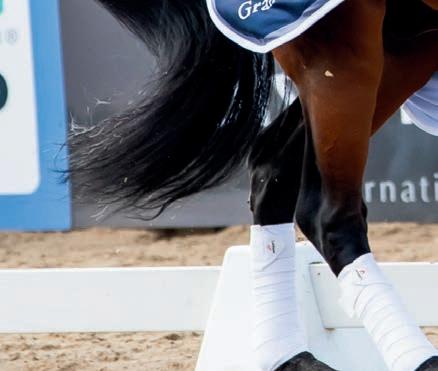

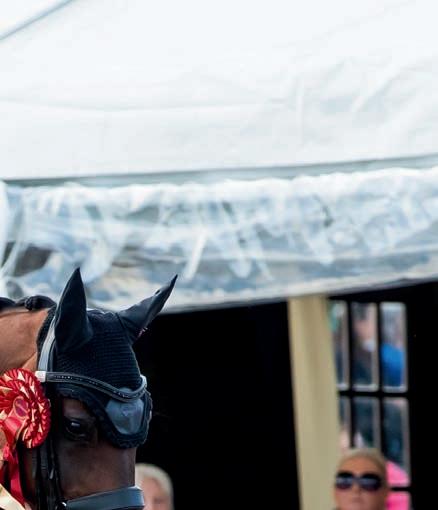

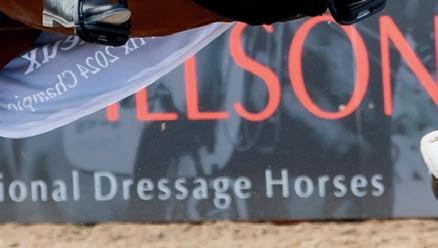



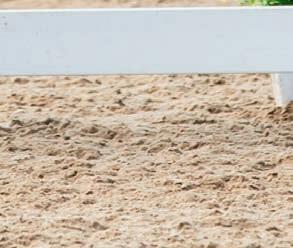










Keep up-to-date with the latest notices, news and views from British Dressage at britishdressage.co.uk

In line with the British Dressage Articles of Association, we can confirm that the BD Training Director and Para Director positions are due for election this year.
These are member elected positions, and both of the current post-holders are eligible to be nominated for election for a second term of four years.
This notice is being posted as required under articles 18.8 and 18.9, to invite those wishing to stand for election to formally submit their nominations.
Nomination forms are available on the British Dressage website, or on request from the BD office, and the closing date for all applications is midday on Tuesday 6 May 2025.
All applicants will then be reviewed by the Nominations Committee, in accordance with Article 23.3, with a shortlist invited
to interview. The successful candidate(s) will then be put forward for election by members in the summer. An electronic ballot will be held over six weeks, from mid-July to late August 2025, with all BD members able to cast their votes online.
The result will be formally announced prior to the 2025 British Dressage Annual General Meeting (date and venue to be confirmed). Please note that the membership vote is binding and not subject to formal ratification at the AGM. However, the positions will continue to take effect from the date of the AGM.
Glenys McKee (List 4) from Scotland, Rachel Hillier (List 2) from South & East, Patricia Mallaburn (List 5) from North & West, and Rosemary Lochery (List 5) and Zoe Feeney (List
4) from North & East have retired from the Judges Panel. British Dressage would like to thank Glenys, Rachel, Patricia, Rosemary and Zoe for their contribution over the years and we wish them all the best for the future.
The Training Director will have input into events such as BD Presents.





From 16 April to 18 May we’ll be celebrating BD Be Kind Month. Do you have something kind to say to someone who helps you? Help us spread positivity and encourage supporting one another by joining in with our online activities and content across the month. Expect collaboration content on mental health with Riders Minds, expert advice from coaches and industry professionals and your own stories of support and kindness. Follow BD social media to follow the campaign, we’ll also be sharing messaging on site at the NAF Five Star Winter Championships, so be sure to visit the BD trade stand.
11-16 Mar Myerscough Premier League, Lancashire
27-30 Mar Para Winter Championships at Arena UK, Lincolnshire
3-6 Apr Chard Equestrian Premier League, Somerset 16-20 Apr NAF Five Star Winter Championships at Addington, Buckinghamshire
2-4 May Addington CPEDI / CDI, Buckinghamshire
10-11 May Combined Training Championships at Weston Lawns, Warwickshire
12-14 May Addington Equestrian Premier League, Buckinghamshire 23 May Somerford Park High Profile, Cheshire
24-25 May Somerford Park Premier League, Cheshire
3-6 Jun Wellington Riding Premier League, Hampshire
5-11 June Wellington CPEDI / CDI, Hampshire
A comprehensive list of major dates can be found online at britishdressage.co.uk/competitions/international-and-major-dates









DO: Vanessa Archer
M: 07398 763414
E: wales@ britishdressage.co.uk
Members: 1,124
Male members: 55

value and that we’re meeting the needs of the members.”
Q: Three events to look forward to in 2025?
Female members: 1,069
Percentage of total UK membership: 6.1%
Youth members (25 & under): 217
Para members: 20
Venues: 16
Judges: 83
Coaches: 34
COUNTIES COVERED
All 22 counties in Wales.
Wales Youth Rep –Anna Roberts.
The Youth Representative plays a vital role in the growth and success of BD Youth activity.
“As Youth Rep, I’m the point of contact for all youth riders and their support teams in the region,” explained volunteer and advocate Anna Roberts, “I’m here to encourage riders to get
Vanessa Archer has served as Development Officer for Wales for nearly nine years. Before taking on the role, she was Event Manager and Show Secretary for The David Broome Event Centre, playing a pivotal role in running a busy, popular show centre. Vanessa’s a non-rider and doesn’t come from a horsey background but has embraced every opportunity to learn on the job. “The equestrian world is fascinating,” she says, “I love how intrigued people are when I tell them about my work.”
Q: What’s the most rewarding aspect of your role?
A: “There’s nothing more satisfying than seeing an event come together and fill up with participants. It’s a clear sign that we’re offering something people
Q: What are your hopes for the Welsh region?
A: “Dressage in Wales is continually growing, and my hopes are for even more opportunities to support that growth. I’d love to see an increase in venues, judges, stewards, and coaches so we can continue to offer accessible, highquality training and competitions that meet everyone’s needs.”
Q: What’s your favourite BD Wales moment to date?
A: “The team events are always a highlight for me. There’s nothing like seeing our riders decked out in Welsh flags and vibrant red clothing, brimming with spirit and pride. Their enthusiasm and camaraderie are truly inspiring and a joy to witness.”
A: 1) Youth camp (24-25 May at Bridgend College) - This is going to be incredible! With squad assessments, rider skills tests, and exciting activities like Equi-Nine Spook Busting, equine massage tips, pole work, horse care and horse hair craft activities.
2) Team events – These are always a standout! The team spirit, support, and camaraderie create an unforgettable atmosphere that truly embodies the essence of community.
3) Zoom topics – I’m thrilled about our planned sessions covering nutrition, Clean Sport, a steward talk, and more informal judge training. These sessions provide valuable insights and bring us together in a more flexible format.
involved, so I regularly attend the summer team events, but also competitions in the local area to chat to people about the pathways and how they could get started.”
Attendance at meetings to discuss opportunities is a part of the role, whilst there’s also an organisational element, as Anna helps set up training days and camps in the region.
“These include lessons, talks from industry experts and even games.”
For Anna, being an open and inspiring figure to new generations is important: “I absolutely loved my time in BD Youth and getting to be involved in other riders’ journeys is equally as exciting for me. I find it really rewarding to see the riders come back year after year because they love it as much as I did. I also love seeing the friendships that the riders make and the support they give each other.”
considering getting involved, Anna says, “Do it!”
Contact details for all Youth reps are available on the BD website, “drop us a message to say you’d like to get involved and we can point you in the right direction to get started,” she explains about providing support at the start of the BD Youth journey. “There’s no pressure, we want young riders to enjoy their ponies, make friends and have fun.” CURRENTLY RECRUITING
To those youngsters who are
To find your local region contacts and infomation on regional training, including camps, test riding, social activities, demos and much more, simply open the camera on your device and scan the codes opposite. Alternatively, visit the BD website, find your region and head to the regional training page via your web browser.






















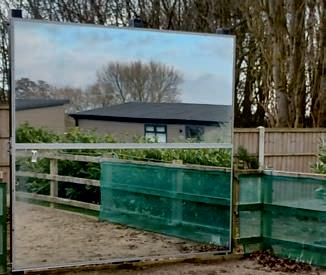













Wellington Riding’s General Manager David Sheerin has worn many hats with great success. As an organiser, David has been instrumental in the success of Wellington, acting as the driving force behind the success of one of BD’s premier centres. In the saddle, he has produced event horses to elite level, and now enjoys BD competition, successfully contesting the FEI levels.
MY EARLIEST MEMORY OF HORSES…
I was eight and being shown how to put a bridle on, as soon as I was left on my own – this little Welsh Section C pony refused to open his mouth. When his owner came near he was obliging and when I was on my own his stubborn streak came back out! This taught me early on that horses deserve respect and are more intelligent than you think.
WHAT DID YOU WANT TO BE WHEN GROWING UP?
BEST EQUESTRIAN ADVICE…
Develop attention to detail as early as you can, whether you’re looking after horses, managing them or riding.
BEST BUSINESS ADVICE...
The equine world is smaller and more diverse than you think, always leave a yard/workplace on good terms. You never know when you will bump into those people again.
AN INSPIRING FIGURE…
Nereide Goodman who was the co-founder of Wellington Riding in the 1970s. She’s been a huge inspiration to my professional and riding career.
A SPECIAL HORSE…


Today’s Special aka Pesto. Over ten years I produced him from the age of three to being an Advanced event horse; he now has a second career as a Para Dressage horse for the Hong Kong Jockey Club.

A Marine Biologist. I dreamt of counting turtles on isolated beaches in the Pacific or Caribbean.
BEST MOMENT IN DRESSAGE SO FAR…
Qualifying for the Nationals in 2024 at Inter I after only having ridden at that level a handful of times. This was on an experienced horse who I feel I was able to showcase in a correct way whilst he was showing me the ropes at this level, very lucky to have this opportunity.
THE PLACES YOU FEEL HAPPIEST…
Riding young horses, I still get a buzz out of being the first person to get on after all the groundwork.
A MOST EMBARRASSING MOMENT…
Was recently when I was getting dressed to leave my house on a Saturday morning with a full day of coaching and I accidentally started to Facebook Live from my pocket on my phone...the whole world could hear me getting my boots on and singing to the musical Wicked!
MY MOST TREASURED POSSESSION…
My mother makes quilts and over the years she has made many for all our families, the first one she ever made me has a wonderful pattern and many memories attached.
A PLACE I’D LIKE TO VISIT?
Machu Picchu in Peru, it’s a fascinating country and I would love to climb high up into the Andes Mountains and see how the Incas lived.



DREAM DINNER PARTY GUESTS
Miriam Margolyes for entertainment, Margaret Thatcher for her tenacity and Gustav Steinbrecht who wrote the Gymnasium of the Horse in 1885, which was widely accepted as a major piece of work in equestrian literature.
MY FAVOURITE BOOK
The Cat in the Hat by Dr Suess; I loved the time reading this to my children when they were young.
MY FAVOURITE TV SERIES/FILM Traitors on the BBC.
WHAT WOULD THE TITLE OF YOUR AUTOBIOGRAPHY BE? Making it Happen.
MY GUILTY PLEASURE…
Ru Pauls Drag Race! It’s light-hearted fun and fabulous. It showcases comedy, fashion and talent in an extraordinary way.
PETS IN YOUR LIFE…
Two working labradors, one black and one fox red, a pygmy goat, runner ducks, chickens, fish in a pond and two teenagers!
HOW DO YOU LIKE TO RELAX?
Making my family breakfast on a Sunday morning with chilled music in the background and having the time to take an afternoon nap...not a common occurrence.


